Abell 1314 is a rather nearby galaxy cluster in Ursa Major below the bowl of the Big Dipper asterism. That is if "nearby" is 460 million light-years. It is described as being 80 minutes of arc across and of morphology class III and richness class 0. By morphology class III they mean it has no obvious anchoring galaxy. Instead, in this case, it has several large elliptical galaxies scattered throughout the cluster though I note the biggest, IC 712 is very near the center as defined by NED. Richness class 0 is more complicated. It says there are 30 to 49 galaxies within a magnitude range of m3 to m3+2. M3 is the brightness of the third brightest galaxy in the cluster. Thus it isn't a measure of how many galaxies the cluster contains though usually, it is a pretty good indicator of relative populations though there are some exceptions. Even though my field doesn't begin to cover the entire cluster the annotated image shows far more than 50 galaxies that are members of the cluster as many are fainter than M3+2 and not counted.
The closest it has to a cD galaxy is the bright cluster galaxy IC 712. I'm rather puzzled by a note at NED on this galaxy. It reads: "1132+493. Owing to its size of 4.6 kpc, this is the smallest known radio galaxy with tailed structure. It is identified with the brightest member of the cluster A1314, which also is characterized by the presence of two extended tailed radio galaxies, IC 711 (Wilson & Vallee 1977) and IC 708 (Vallee et al. 1981). The tails of these 3 cluster radiogalaxies point in different directions with respect to the cluster center." Considering the other two it mentions are smaller in my image and the size of IC 712 visually is about 40 kpc I suppose they mean its radio size rather than it's optical size.
Near IC 712 is a strange looking galaxy with the tongue-twister name of Mr19:[BFW2006] 14242 NED18. It's a somewhat distorted looking two arm spiral. Unfortunately, I can't find anything else on it.
The 4 IC galaxies were discovered by Lewis Swift on May 11, 1890.
Even more puzzling is the blue galaxy trying to hide behind the brilliant orange star HD 200597 to the upper left of IC 712. SIMBAD identifies nothing at this location and NED shows only a 21st magnitude star. Another case of NED missing a rather obvious blue galaxy which is a surprisingly common occurrence, especially when it is interesting looking and I'd like to know more about it.
Another odd object is the much closer to us at 13 to 21 billion light-years, Markarian galaxy MRK 0178 in the upper left corner. It is a dwarf galaxy with two large blue HII regions and lots of hints of smaller star clusters scattered about this irregular dwarf galaxy with a lot of Wolf Rayet stars. A star in our galaxy is seen against it just to the upper right of the two main HII regions. While some papers indicate they can't tell if it is a star or a feature of the galaxy I'm quite certain it is a field star. The PSF is the same as stars in that part of my image and very different from the other features of the galaxy.
I was surprised to find the galaxy MCG+08-21-054 in the lower right corner had no distance or classification. Looks much like a Scd galaxy to me. Why its redshift is yet to be determined (or maybe just yet to be picked up by NED) I don't know. If a cluster member, it is one of the few "classic" spirals in the cluster.
To its lower left is PGC 97398 which NED identifies as a quasar candidate. It is starlike all right but at the distance of the cluster, 440 million light-years awfully close and faint for a quasar. But then what else could it be? I keep finding puzzling objects in this at first rather ordinary appearing field for a nearby galaxy cluster.
14" LX200R @ f/10, L=4x10' RGB=2x10' STL-11000XM, Paramount ME Related Designations for ABELL1314ABELL 1314, UGCl 226, ZwCl 1131.2+4923, MCXC J1134.8+4903, RBS 1000, 1RXS J113448.4+490438, RXC J1134.8+4903, EXSS 1132.0+4920, NGC 0711, UGC 01342, CGCG 460-038, CGCG 0149.7+1716, MCG +03-05-024, 2MASX J01522780+1730450, 2MASXi J0152278+173045, 2MASS J01522779+1730456, LDCE 0118 NED001, HDCE 0101 NED001, NPM1G +17.0073, NSA 130596, PGC 006940, UZC J015227.8+173046, LGG 036:[G93] 005, IC 0708, UGC 06549, CGCG 242-048, CGCG 1131.2+4920, MCG +08-21-056, 2MASX J11335920+4903432, 2MASXi J1133592+490343, 2MASS J11335923+4903433, SDSS J113359.22+490343.6, SDSS J113359.23+490343.3, SDSS J113359.23+490343.4, GALEXASC J113359.21+490343.6 , GALEXMSC J113359.14+490345.0 , WBL 339-001, LDCE 0818 NED001, HDCE 0655 NED001, USGC U401 NED07, ASK 219359.0, MAPS-NGP O_170_0081306, NFGS 086, NSA 038421, PGC 035720, UZC J113359.1+490345, 87GB 113112.8+492042, 87GB[BWE91] 1131+4920, [WB92] 1131+4920, NVSS J113358+490346, VLSS J1133.9+4903, TXS 1131+493, GB1 1131+493, Papillon, 2XMM J113359.2+490344, 2XMMp J113359.2+490344, ABELL 1314:[HKW78] 01, ABELL 1314:[L84] G2, [OSO87] 1131+493, ABELL 1314:[ATS88] 01, ABELL 1314:[ZBO89] R2, ABELL 1314:[FTC95] 001, ABELL 1314:[LO95] 1131+493, [SM2000] 1131+493, [BFW2006] J173.49678+49.06213 , Mr18:[BFW2006] 06984 NED19, Mr19:[BFW2006] 14242 NED11, Mr20:[BFW2006] 23364 NED08, [JBB2007] J113359.22+490343.4 , [GMM2009] 0658587, [LPP2009] 1131+493, [TTL2012] 097078, SDSS J113359.22+490343.7, [GMM2015] J113359.2+490343, IC 0709, CGCG 242-049, CGCG 1131.5+4919, MCG +08-21-057, 2MASX J11341457+4902352, 2MASXi J1134145+490235, 2MASS J11341454+4902355, SDSS J113414.53+490235.4, SDSS J113414.53+490235.6, SDSS J113414.54+490235.3, SDSS J113414.54+490235.4, GALEXASC J113414.54+490236.5 , GALEXMSC J113414.61+490235.2 , WBL 339-002, LDCE 0818 NED002, HDCE 0655 NED002, USGC U401 NED06, ASK 219355.0, MAPS-NGP O_170_0101730, NPM1G +49.0200, NSA 038419, PGC 035736, UZC J113414.5+490235, 2XMM J113414.4+490235, 2XMMp J113414.4+490235, ABELL 1314:[FTC95] 003, [BFW2006] J173.56056+49.04324 , Mr18:[BFW2006] 06984 NED23, Mr19:[BFW2006] 14242 NED13, Mr20:[BFW2006] 23364 NED09, [TTL2012] 097076, SDSS J113414.53+490235.7, IC 0712, CGCG 242-054, CGCG 1132.1+4921, MCG +08-21-063, 2MASX J11344932+4904388, 2MASXi J1134493+490439, 2MASS J11344930+4904392, SDSS J113449.29+490439.4, SDSS J113449.29+490439.5, SDSS J113449.29+490439.7, SDSS J113449.30+490439.4, SDSS J113449.30+490439.5, GALEXASC J113449.04+490441.0 , GALEXMSC J113449.16+490438.1 , WBL 339-004, LDCE 0818 NED004, HDCE 0655 NED004, USGC U401 NED03, BMW-HRI J113448.9+490440, ASK 218758.0, NSA 038400, PGC 035785, UZC J113449.3+490440, 20P 039, 1132+49W3, CXO J113449.3+490439, 2XMM J113449.3+490439, 2XMMp J113449.2+490439, ABELL 1314:[ZBO89] O4, ABELL 1314:[ZBO89] R4, ABELL 1314:[FTC95] 002, ABELL 1314:[PL95] BCG, [OL97] 1132+493, ABELL 1314:[BTM97] 1, ABELL 1314:[CAE99], RX J1134.8+4904:[ZEH2003] 04 , [BFW2006] J173.70539+49.07772 , Mr18:[BFW2006] 06984 NED39, Mr19:[BFW2006] 14242 NED21, Mr20:[BFW2006] 23364 NED11, [GMM2009] 0658603, [LPP2009] 1132+493, [TTL2012] 094703, SDSS J113449.28+490439.8, UGC 06541, MRK 0178, SBS 1130+495, CGCG 242-046, CGCG 1130.8+4931, MCG +08-21-053, SDSS J113328.94+491412.9, SDSS J113328.94+491413.0, SDSS J113328.95+491413.0, [RC2] A1130+49, ASK 219349.0, ASIAGO4 05, BTS 034, HOLM 263A, MAPS-NGP O_170_0080906, NSA 038414, PGC 035684, LEDA 200273, UZC J113328.9+491421, 11HUGS 237, [SPB93] 156, ABELL 1314:[FTC95] 008, [TCW2007] 099, [BKD2008] WR 199, [SB2012] 064, ABELL1314, NGC0711, IC0708, IC0709, IC0712, MRK0178, [PJY2015] 588295841247657994 , | 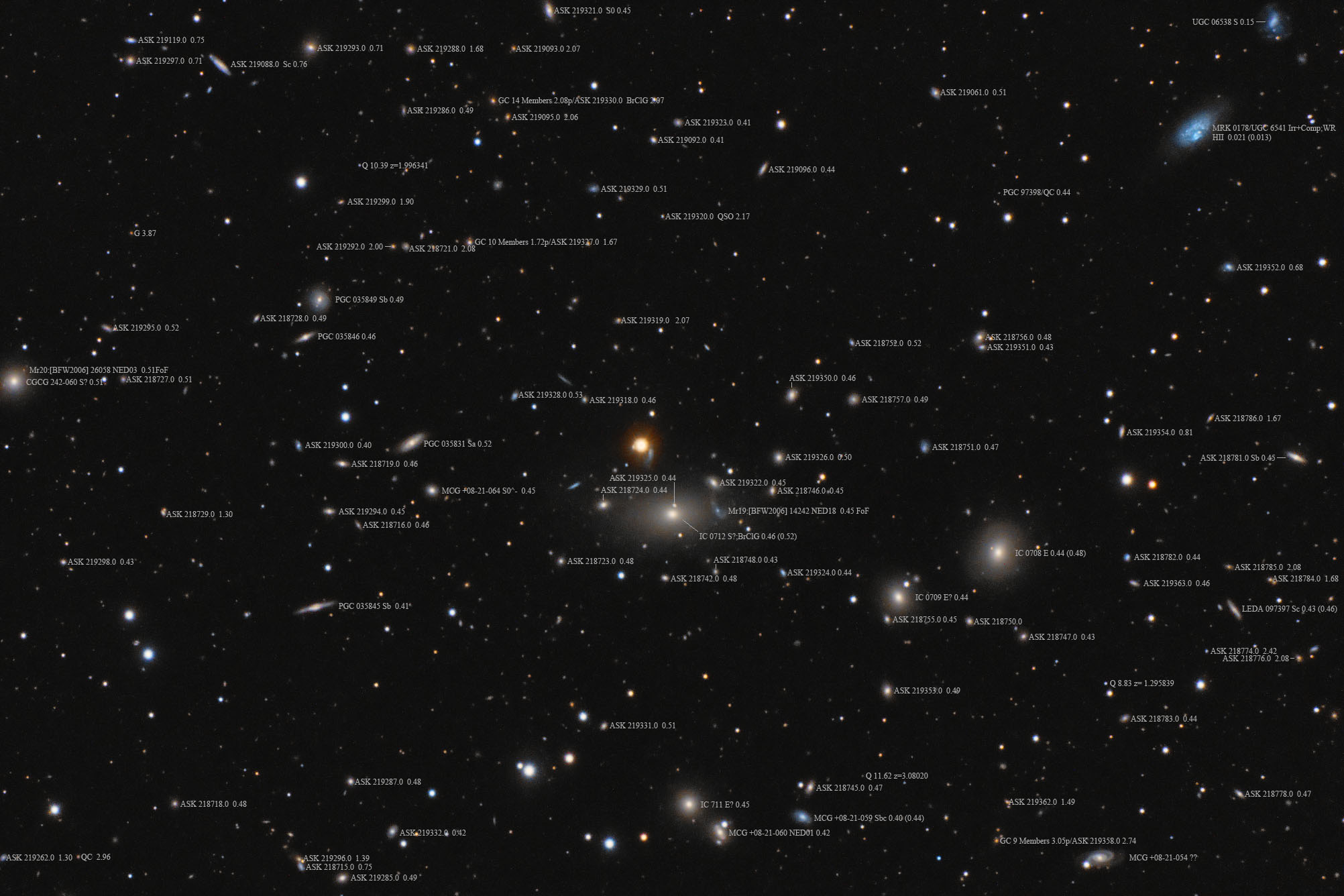
ABELL1314L4X10RGB2X10R-ID.JPG

ABELL1314L4X10RGB2X10R.JPG
| Edit: I originally posted this image back in April 2008. There were processing issues with it as well as not having an annotated image for this very crowded field. I decided it needed a reprocess. With rotten imaging weather I took some time away from processing my backlog to rework this image.
Abell 1367 is a very large, galaxy cluster in Leo not far from the outskirts of the far more famous and 5 times closer Virgo Galaxy Cluster. It is a bit over 300 million light-years distant. NGC 3842 is its major galaxy. It is some 230,000 light-years in diameter. Though measuring it is difficult as its halo overlaps that of its neighbor NGC 3841. Just to the northwest is a huge blue galaxy, UGC 6697. It measures out at 220,000 light-years across. It is classed as an irregular Magellan class galaxy. These are normally small to dwarf sized galaxies rather than huge disk galaxy that this one appears to be. Below it is a blue star-like object that some surveys show as a star others galaxy. If a star the 290 million light-year distance is obviously wrong. Still it looks like a star in my image. Other star/galaxy questionable objects are seen in the image
On the eastern side of NGC 3842 is a quasar with a redshift distance of 7.56 billion light-years. NED shows at the same position that its light apparently travels through two closer dust and gas clouds. Though the redshift of one indicates it is further away than the quasar. Two possibilities. Since both are listed as an absorption feature. This normally only happens when the object is closer so we see the quasar through it. It then adds its own absorption lines to the quasars. This means that while it is closer it is moving toward the quasar giving it a greater velocity in relation to the quasar. Several other quasars are seen in the image.
One galaxy cluster is labeled north of UGC 6697. While the photographic redshift for it and the Big Cluster Galaxy was exactly the same the positions were somewhat different. I used a line from the GC label to the cluster's center position and another to the BCG. Though the position to the cluster was listed with an error bar sufficient to include the BCG I opted to show both. Usually the two agree considerably more closely than this pair do.
Several pairs of galaxies can be seen in the image. In some cases one is star-like, in others appear unrelated and just line of sight pairs such as NGC 3861 and 3861B on the left side of the image. Near the top is the apparently interacting pair of CGCG 097-102 north and south. While CGCG 097-092 NED01 is peculiar it has somewhat differ redshift that CGCG 097-092 NED02. Others such as ABELL 1367:[GP82]0615 have plumes but no interacting galaxy in the area.
The oddest of the odd is what NED lists as a galaxy pair on the far left, CGCG 097-133. For the one listed as being north and the one listed as being east NED has redshifts of 680 and 660 million light-years though what exactly is the eastern member I can't determine. This is confused by NED listing the distance to the pair at 250 million light-years! The group appears to me to be at least four objects. I've attached the Sloan image of the group which also appears to be four or five objects in a group. I'd love to see what Hubble shows for this group. Unfortunately, that's apparently not happened.
If an object was not a part of the cluster and was identified only by a catalog entry that was its coordinates in the sky it is labeled by G for galaxy and Q for quasar. Otherwise its catalog name is used. I had to use a lot of lines to avoid labels from obscuring other objects.
14" LX200R @ f/10, L=10x10' RGB=2x10'x3, STL-11000XM, Paramount ME Related Designations for ABELL1367 NGC3840UGC 06697, KUG 1141+202, CGCG 097-087, CGCG 1141.2+2015, MCG +03-30-066, 2MFGC 09207, 2MASX J11434911+1958063, 2MASXi J1143489+195808, 2MASS J11434913+1958061, SDSS J114349.07+195806.4, SDSS J114349.07+195806.5, IRAS 11412+2014, IRAS F11412+2014, AKARI J1143484+195803, WBL 353-022, LDCE 0836 NED017, HDCE 0672 NED010, USGC U416 NED55, AGES J114347+195820, NSA 140139, PGC 036466, SSTSL2 J114349.15+195805.6, UZC J114349.2+195806, NVSS J114349+195811, UITBOC 1673, 2XMM J114349.2+195804, ABELL 1367:[BFG83] 08, ABELL 1367:[BO85] 012, [OSO87] 1141+202, ABELL 1367:[MWI88] 22, ABELL 1367:[ZBO89] O1, ABELL 1367:[ZBO89] R1, ABELL 1367:[OWG93] B, [GC94] 58, [AO95] 1141+202A, ABELL 1367:[GFJ95] PSPC 04, [M98j] 144 NED03, ABELL 1367:[LCR98] 07, [MO2001] J114348.6+195811.0, [IBC2002] J114348+195812, ABELL 1367:[SM2002] C9, ABELL 1367:[SM2002a] 03, [IBG2003] J114348+195812, [MOL2003] J114348+195810, UGC 06697:[SV2005] P3, [TCW2007] 103, RSCG 44:[WBJ2013] C, [DZ2015] 650-10, [VFK2015] J175.95403+19.96882 , NGC 3840, UGC 06702, KUG 1141+203, CGCG 097-091, CGCG 1141.3+2021, MCG +03-30-070, 2MASX J11435898+2004373, 2MASXi J1143590+200437, 2MASS J11435896+2004374, SDSS J114358.95+200437.2, SDSS J114358.96+200437.3, IRAS 11413+2021, IRAS F11413+2021, AKARI J1143591+200440, WBL 353-025, LDCE 0836 NED019, HDCE 0672 NED012, USGC U416 NED52, AGES J114358+200430, ASK 629196.0, MAPS-NGP O_434_0018144, NSA 113068, PGC 036477, REIZ 1531, SSTSL2 J114358.95+200437.6, UZC J114358.9+200438, CXO J114359.0+200438, 2XMM J114359.1+200435, ABELL 1367:[GP82] 0926, ABELL 1367:[BFG83] 13, ABELL 1367:[BO85] 016, ABELL 1367:[MWI88] 25, [GC94] 61, [STE2000] 114123.40+202116.6 , [MO2001] J114359.0+200435.9, [IBC2002] J114358+200433, [IBG2003] J114358+200432, [TTL2012] 142065, SDSS J114358.96+200437.2, NGC 3841, CGCG 097-096, CGCG 1141.4+2015, MCG +03-30-073, 2MASX J11440217+1958183, 2MASXi J1144022+195819, 2MASS J11440216+1958188, SDSS J114402.15+195818.8, SDSS J114402.16+195818.8, SDSS J114402.16+195818.9, GALEXASC J114402.40+195818.4 , GALEXMSC J114402.07+195818.1 , WBL 353-030, LDCE 0836 NED022, HDCE 0672 NED015, USGC U416 NED47, ASK 630508.0, NSA 113461, PGC 036469, SSTSL2 J114402.15+195819.1, UZC J114402.2+195818, ABELL 1367:[GP82] 0900, ABELL 1367:[BFG83] 17, ABELL 1367:[BO85] 017, ABELL 1367:[LO95] C11, [IBG2003] J114402+195818, RSCG 44:[WBJ2013] D, [TTL2012] 162056, SDSS J114402.15+195818.9, [DZ2015] 650-13, NGC 3842, UGC 06704, CGCG 097-095, CGCG 1141.4+2013, MCG +03-30-072, 2MASX J11440217+1956593, 2MASXi J1144022+195659, 2MASS J11440216+1956594, SDSS J114402.15+195659.3, SDSS J114402.16+195659.3, GALEXASC J114402.21+195658.8 , WBL 353-028, LDCE 0836 NED021, HDCE 0672 NED014, USGC U416 NED48, ASK 630499.0, MAPS-NGP O_434_0018205, NFP J114402.2+195700, NSA 113453, PGC 036487, SSTSL2 J114402.19+195659.0, UZC J114402.1+195659, NVSS J114401+195656, CXO J114402.1+195657, 2XMM J114402.1+195659, 2XMMp J114402.2+195659, ABELL 1367:[GP82] 0899, ABELL 1367:[BFG83] 16, ABELL 1367:[L84] G1, ABELL 1367:[BO85] 002, ABELL 1367:[ZBO89] O3, ABELL 1367:[ZBO89] R3, ABELL 1367:[OWG93] C, [GC94] 65, ABELL 1367:[GFJ95] PSPC 08, ABELL 1367:[PL95] BCG, [OL97] 1141+202B, ABELL 1367:[BTM97] 1, [M98j] 144 NED05, [MO2001] J114402.2+195658.1, ABELL 1367:[SM2002a] 04, [IBG2003] J114402+195658, [HMD2010] J114402.2+195659.3 , ABELL 1367:[ZAC2011] BCG, RSCG 44:[WBJ2013] A, [TTL2012] 162047, [DZ2015] 650-01, NGC 3851, ARK 316, CGCG 097-106, CGCG 1141.7+2015, MCG +03-30-077, 2MASX J11442041+1958508, 2MASXi J1144204+195850, 2MASS J11442040+1958510, SDSS J114420.41+195851.0, SDSS J114420.42+195851.0, SDSS J114420.42+195851.1, GALEXASC J114420.40+195850.7 , GALEXMSC J114420.46+195851.3 , WBL 353-038, LDCE 0836 NED026, HDCE 0672 NED019, USGC U416 NED42, AGC 210691, ASK 630531.0, MAPS-NGP O_434_0018421, NFP J114420.4+195851, NSA 113470, PGC 036516, SSTSL2 J114420.44+195851.1, UZC J114420.4+195851, 2XMM J114420.5+195850, 2XMMp J114420.4+195850, ABELL 1367:[GP82] 0771, ABELL 1367:[BFG83] 25, ABELL 1367:[BO85] 038, [IBG2003] J114420+195850, [TTL2012] 162078, SDSS J114420.41+195851.1, [DZ2015] 650-20, NGC 3861, UGC 06724, KUG 1142+202B, CGCG 097-129 NED01, CGCG 097-129W, CGCG 1142.5+2015 NED01, MCG +03-30-093, 2MASX J11450387+1958249, 2MASXi J1145038+195824, 2MASS J11450387+1958251, SDSS J114503.87+195825.2, SDSS J114503.88+195825.2, IRAS 11424+2015, IRAS F11424+2015, KPG 299A, WBL 353-057, LDCE 0836 NED033, HDCE 0672 NED026, USGC U416 NED25, AGES J114503+195832, ASK 629260.0, HOLM 287A, NFP J114503.9+195827, NSA 113107, PGC 036604, SSTSL2 J114503.81+195825.3, UZC J114503.9+195826, NVSS J114504+195824, 2XMM J114503.8+195825, 2XMMp J114503.8+195825, ABELL 1367:[GP82] 0532, ABELL 1367:[BFG83] 45, ABELL 1367:[BO85] 003, LGG 249:[G93] 004, [GC94] 83, ABELL 1367:[GFJ95] PSPC 23, [M98j] 142 NED03, ABELL 1367:[LCR98] 09, [MO2001] J114504.0+195824.3, ABELL 1367:[SM2002a] 02, [IBG2003] J114503+195825, [TTL2012] 142379, UGC 06719, CGCG 097-121, CGCG 1142.2+2024, MCG +03-30-089, 2MASX J11444705+2007299, 2MASXi J1144470+200730, 2MASS J11444703+2007304, SDSS J114447.03+200730.3, SDSS J114447.04+200730.3, WBL 353-050, LDCE 0836 NED028, HDCE 0672 NED021, USGC U416 NED33, AGES J114447+200737, MAPS-NGP O_434_0006046, NFP J114446.9+200731, NSA 140175, PGC 036574, UZC J114447.0+200730, ABELL 1367:[GP82] 0616, ABELL 1367:[BO85] 011, [GC94] 74, [STE2000] 114211.59+202409.7 , [MO2001] J114447.1+200728.9, [IBG2003] J114447+200729, [TTL2012] 143325, SDSS J114447.04+200730.2, [DZ2015] 650-08, ABELL1367 NGC3840, UGC06697, NGC3840, NGC3841, NGC3842, NGE3845, NGC3851, NGC3861, UGC06719, ECO 02995, ECO 03001, ECO 03006, ECO 03005, [PJY2015] 587742572687786132 , ECO 03013, ECO 03032, ECO 03027, | 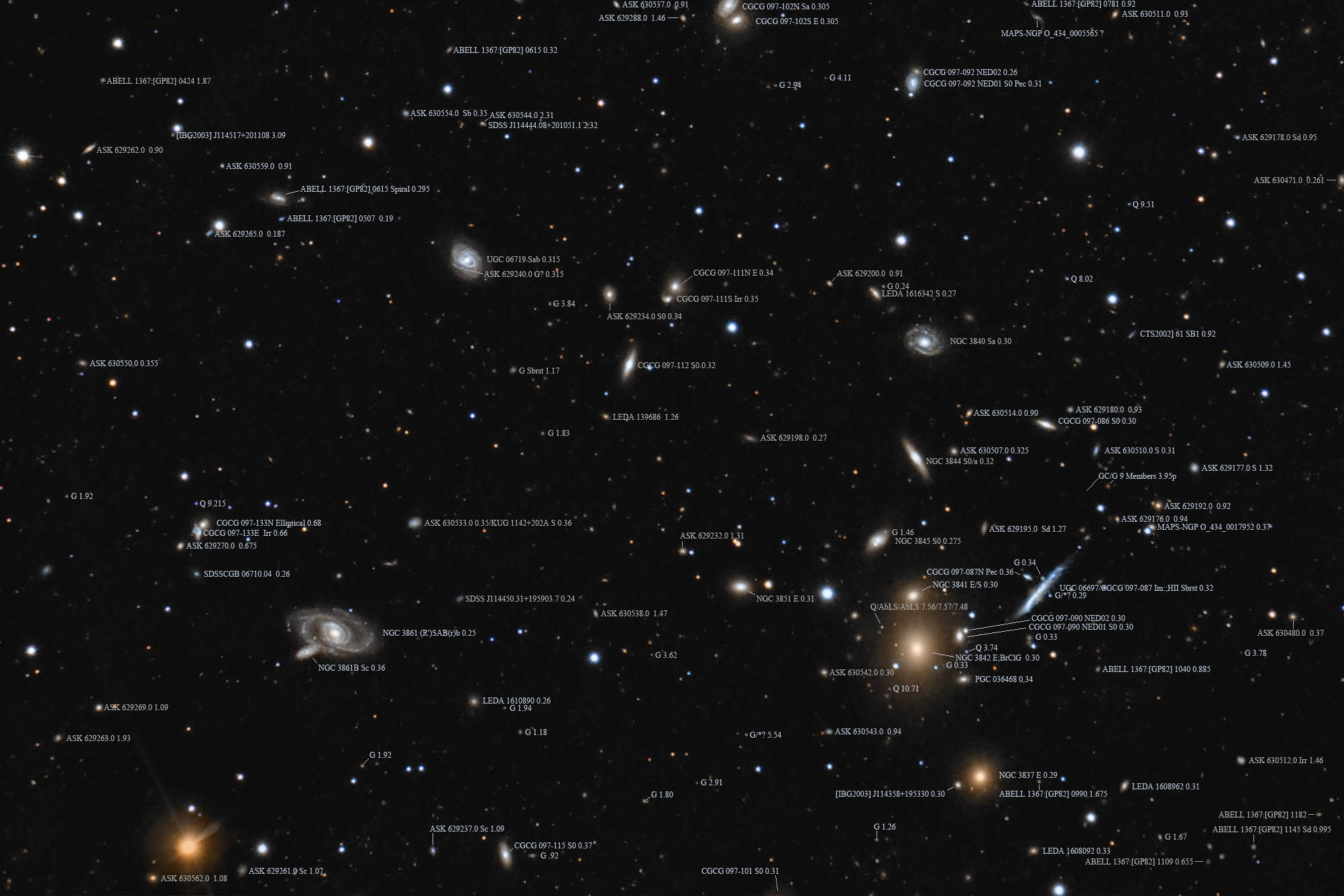
A1367NGC3840L10X10RGB2X10X3R3ID.JPG
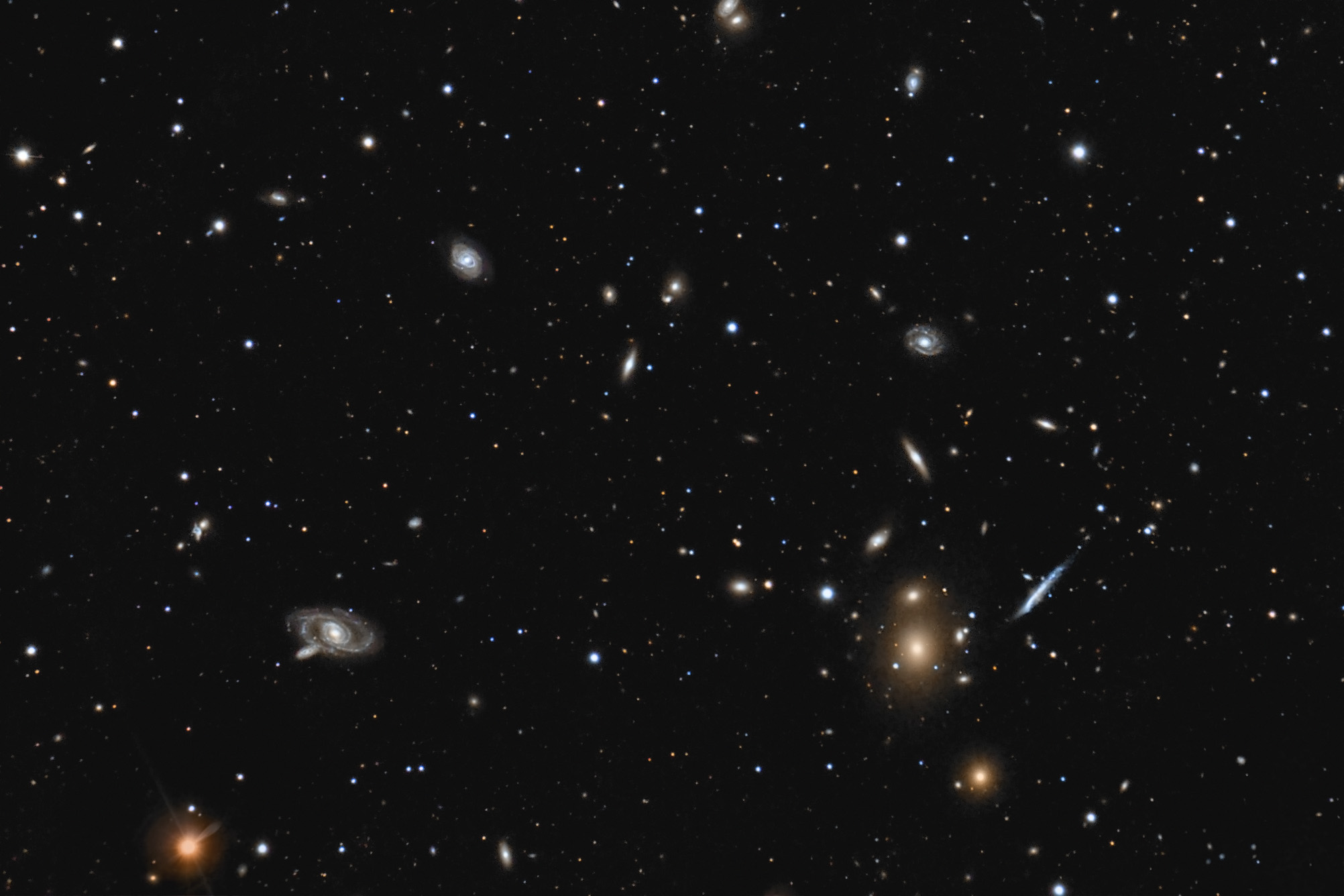
A1367NGC3840L10X10RGB2X10X3R4.JPG
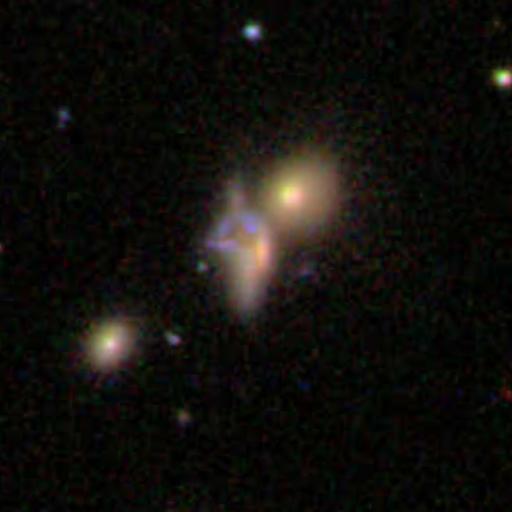
SDSS_Strange object.jpg
| While I'd taken some of the spiral galaxies that hover around the edges of the Coma Cluster of galaxies, ABELL 1656, I'd not taken the center of it which is mostly S0 and elliptical galaxies. My field of view isn't sufficient to begin to cover the cluster. NED lists it as having a diameter of 5.33 degrees. I'd need over 100 images to cover it all. Fortunately, it is highly concentrated so I get a lot of its members by taking the center. NED lists it as having 484 members which is a severe understatement as there are over 1000 galaxies in my image alone with redshift data. Far too many for me to even think about annotating. I settled on just listing those in the IC and NGC catalogs plus a couple PGC galaxies about as big and bright as the NGC and IC galaxies. The cluster has two main cD type galaxies that are huge and thus anchor gravitationally the cluster's vast members. The normally sized galaxies look like moths swarming around two lights being small in comparison to these two monsters. The cluster is listed with a redshift that puts it 330 million light-years distant. At first, I wasn't going to include distance figures for these since they all are about this distance. But due to their orbiting the barycenter of the cluster which is rather massive they can have rather high velocities toward or away from us. Also listed in parenthesis is the non-redshift distances which usually stick much closer to the 330 million light-year distance than does the redshift values. Comparing the two seemed interesting so I decided to include these distance estimates.
For some reason, I seem to have centered on the western one NGC 4874 so I'll start this huge text file there. NED lists 71 different catalog entries for it. SIMBAD adds a few more. SIMBAD also lists 1850 reference paper on it. Needless to say, I didn't begin to check them out as I would normally do. NGC 4874 is a huge, very diffuse galaxy. This makes determining its size difficult as it has no obvious edge to key on. Also, the halos around all the galaxies hovering about it add to this confusion. Best I can say is it is at least 250" of arc across which gives it a diameter of some 400,000 light-years. Now that's big. It has no sign of dust or gas, just old stars, and a jet of plasma seen by radio telescopes that extends some 1700 light-years from the core indicating it has an active supermassive black hole at its core. Hubble shows it is surrounded by many globular clusters as well as globular cluster sized galaxy cores. Apparently, only these cores remain after losing the rest of their stars to the massive galaxy. These are too faint for me to pick up. The galaxy was discovered by William Herschel on April 11, 1785. I was surprised that it isn't in either H400 observing program.
Above and a bit right of NGC 4874 is an odd wedge-shaped diffuse object pointing to the right. Is it a piece of IFN much brighter than the hits I see elsewhere in the image or stars. I didn't find anything on it. If anyone does please let me know. Also, as shown on the annotated image NGC 4874 carries a Di classification while 4887/9 a Dd classification. A lone D stands for Diffuse in an obscure classification system devised by William Morgan. But that had no further subdivision that I can find. He's the one that came up with cD for big diffuse galaxies that anchor galaxy clusters. That's the only piece of his system that is still used. So I asked NED what Dd and Di meant. They replied they couldn't find out either saying; "I have to claim that they have been "lost in the ether"." They did then say "BTW, we have changed our procedures such that this type of data tracking will not lose anything again." That indicates there are likely similar problems at the site of this at NASA's site. If any history buff knows about these designations please let me know and I'll pass it on to NED (NASA/IPAC Extragalactic Database).
The other anchoring galaxy is NGC 4884/89. Like NGC 4874 is it so diffuse determining its size is extremely difficult. I get a size of about 3 minutes of arc so it isn't as large. That translates to 300,000 light-years. But both galaxies have a very large halo encompassing both. It extends some 17 minutes of arc in my FITS stack. That would make the two some 1.6 million light-years across. There is some IFN in the background as well making this measurement somewhat iffy. It carries two NGC numbers. William Herschel found it on the same night as NGC 4874 and got the position right. Then 80 years later, April 22, 1865, Heinrich d'Arrest found it but apparently gave slightly wrong coordinates. This caused Dreyer to enter it again as NGC 4884 when compiling his catalog that became the NGC. Most use the NGC 4889 designation. It isn't in either H400 program either.
As there are so many IC and NGC galaxies I'm just going to list their discovery info. A few warrant a bit more detail. I'm taking them right to left across the image.
IC 3943 Discovered by Hermann Kobold on May 28, 1895
IC 3946 Discovered by Hermann Kobold on May 12, 1896
IC 3949 NED says it is SA0 while Seligman says Sb? I prefer Seligman. Found by Kobold also on May 12, 1896.
NGC 4858 Discovered by Heinrich d'Arrest on April 21, 1865 Not likely a cluster member
NGC 4860 Discovered by Heinrich d'Arrest on April 21, 1865
IC 3955 Discovered by Hermann Kobold on April 22, 1895
IC 3960 Discovered by Hermann Kobold May 12, 1896
NGC 4864 Discovered by John Herschel April 13, 1831
NGC 4867 Discovered by Heinrich d'Arrest on May 10, 1863
NGC 4869 Discovered by William Herschel on April 11, 1785
NGC 4871 Discovered by Heinrich d'Arrest on May 10, 1863
IC 3976 Discovered by Hermann Kobold on May 13, 1896
IC 3973 Discovered by Hermann Kobold on May 20, 1895 Either 3973 or 3976 is out of RA order.
NGC 4873 Discovered by Heinrich d'Arrest on May 10, 1863
NGC 4872 Discovered by Heinrich d'Arrest date unknown It or 4873 is out or RA order.
NGC 4875 and NGC 4876 Discovered by Guillaume Bigourdan on May 16, 1885
IC 3998 Discovered by Hermann Kobold on April 22, 1895
NGC 4883 Discovered by Heinrich d'Arrest on April 22, 1865
NGC 4882/4886 Discovered by Heinrich d'Arrest on April 22, 1865 and April 6, 1864 respectively. I assume he got one of the positions wrong leading to two entries. He wasn't very good with his coordinates.
IC 4011 Discovered by Hermann Kobold on April 22, 1895
IC 4012 Discovered by Hermann Kobold on May 11, 1896
IC 4021 Discovered by Hermann Kobold on May 11, 1896
NGC 4894 Discovered by John Herschel on March 30, 1827
NGC 4898 Discovered by Heinrich d'Arrest on April 6, 1864. A pair of galaxies, PGC 3098454 to the north and PGC 44736 to the south
IC 4026 Discovered by Hermann Kobold on May 11, 1896
IC 4030 Discovered by Hermann Kobold on May 9, 1896
IC 4033 Discovered by Hermann Kobold on May 9, 1896
IC 4040 Discovered by Guillaume Bigourdan on April 12, 1891, Seligman classifies it as Sbc? pec
NGC 4906 Discovered by Heinrich d'Arrest on April 6, 1864
IC 4041 Discovered by Hermann Kobold on May 8, 1896
IC 4042 Discovered by Hermann Kobold on May 9, 1896
IC 4044 Discovered by Hermann Kobold on May 9, 1896
NGC 4907 Discovered by Heinrich d'Arrest on May 5, 1864 Most likely not a cluster member
IC 4045 Discovered by Guillaume Bigourdan on April 12, 1891
IC 4051 Discovered by Guillaume Bigourdan on April 12, 1891
14" LX200R @ f/10, L=4x10' RGB=2x10' (haze limited), STL-11000XM, Paramount ME Related Designations for ABELL1656Coma Cluster, ABELL 1656, UGCl 276, CID 90, CAN 090, USGC U508, ZwCl 1257.1+2806, SCL 117 NED02, RASSCALS NRGb 226, PLCKESZ G057.33+88.01, IGR J12595+2755, MAXI J1259+279, 2PBC J1259.5+2756, SAXWFC J1259.5+2756.6, EXSS 1257.4+2815, 1ES 1257+282, XSS J12596+2759, SWIFT J1259.4+2757, SWIFT J1259.7+2755, [ZGH93] G074, [RPG97] 226, [KVC2005] 08, [KRL2007] 128, ABELL1656, | 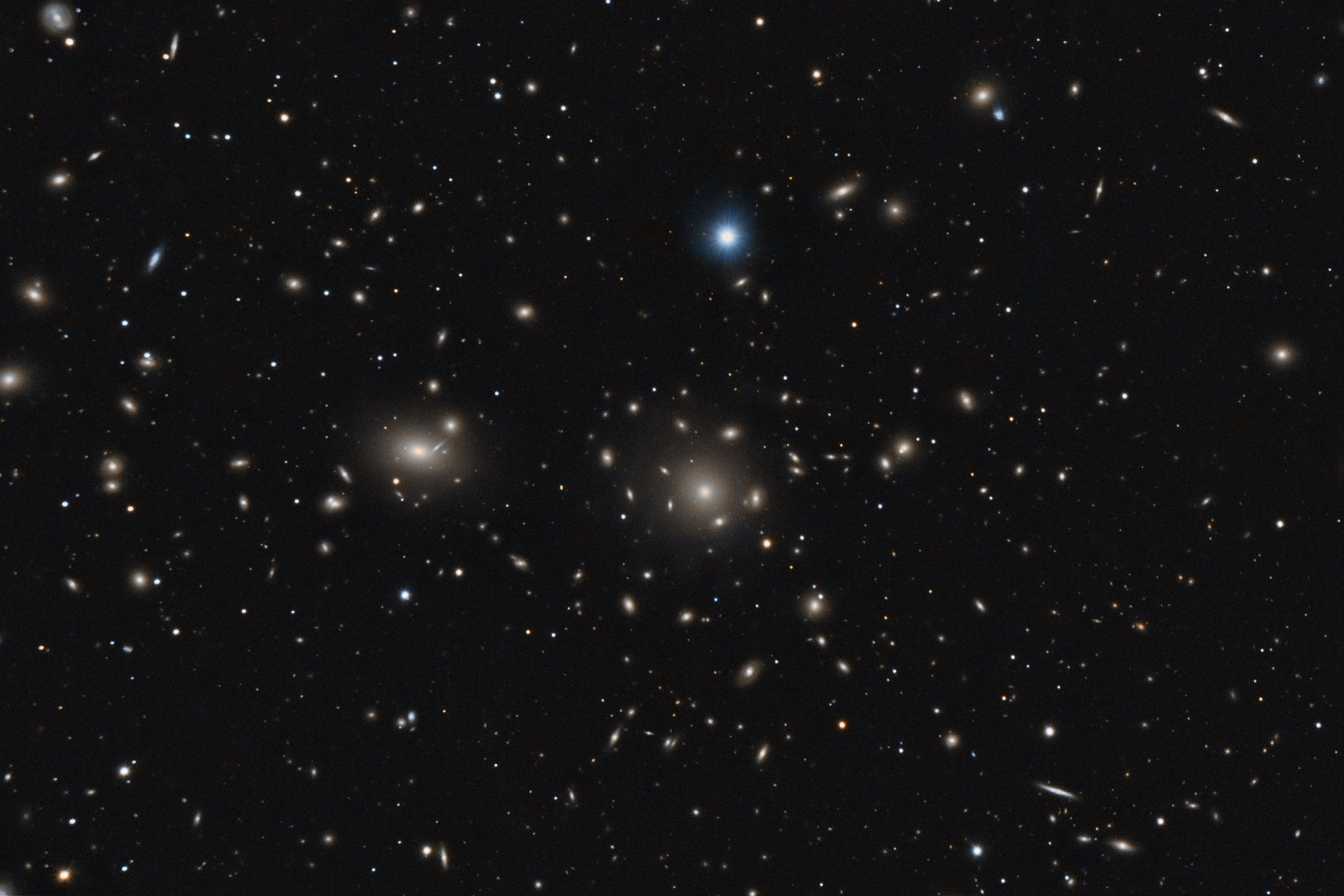
NGC4874L4X10RGB2X10.JPG
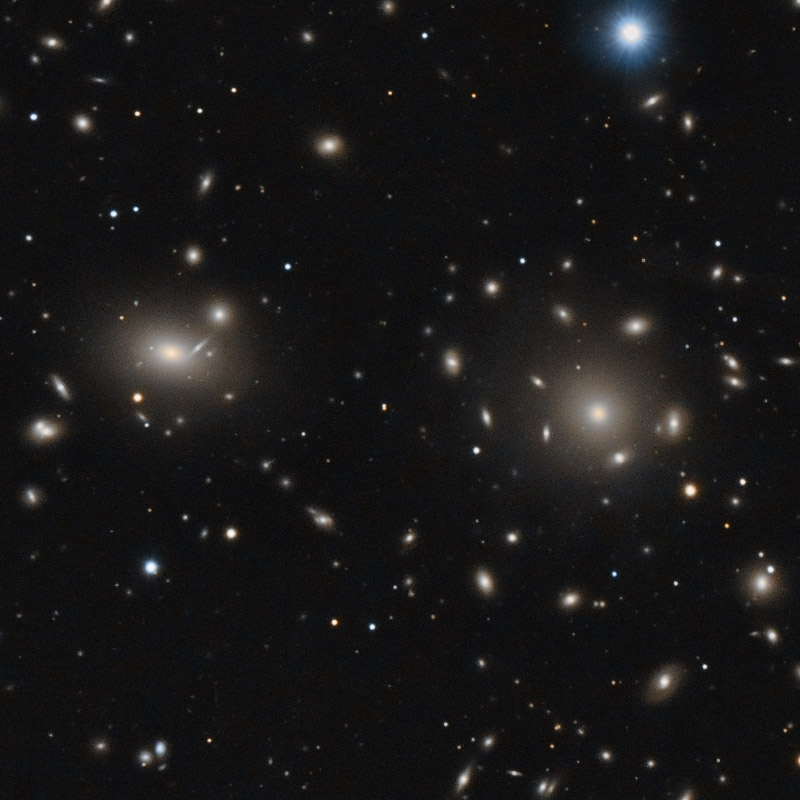
NGC4874L4X10RGB2X10CROP.JPG
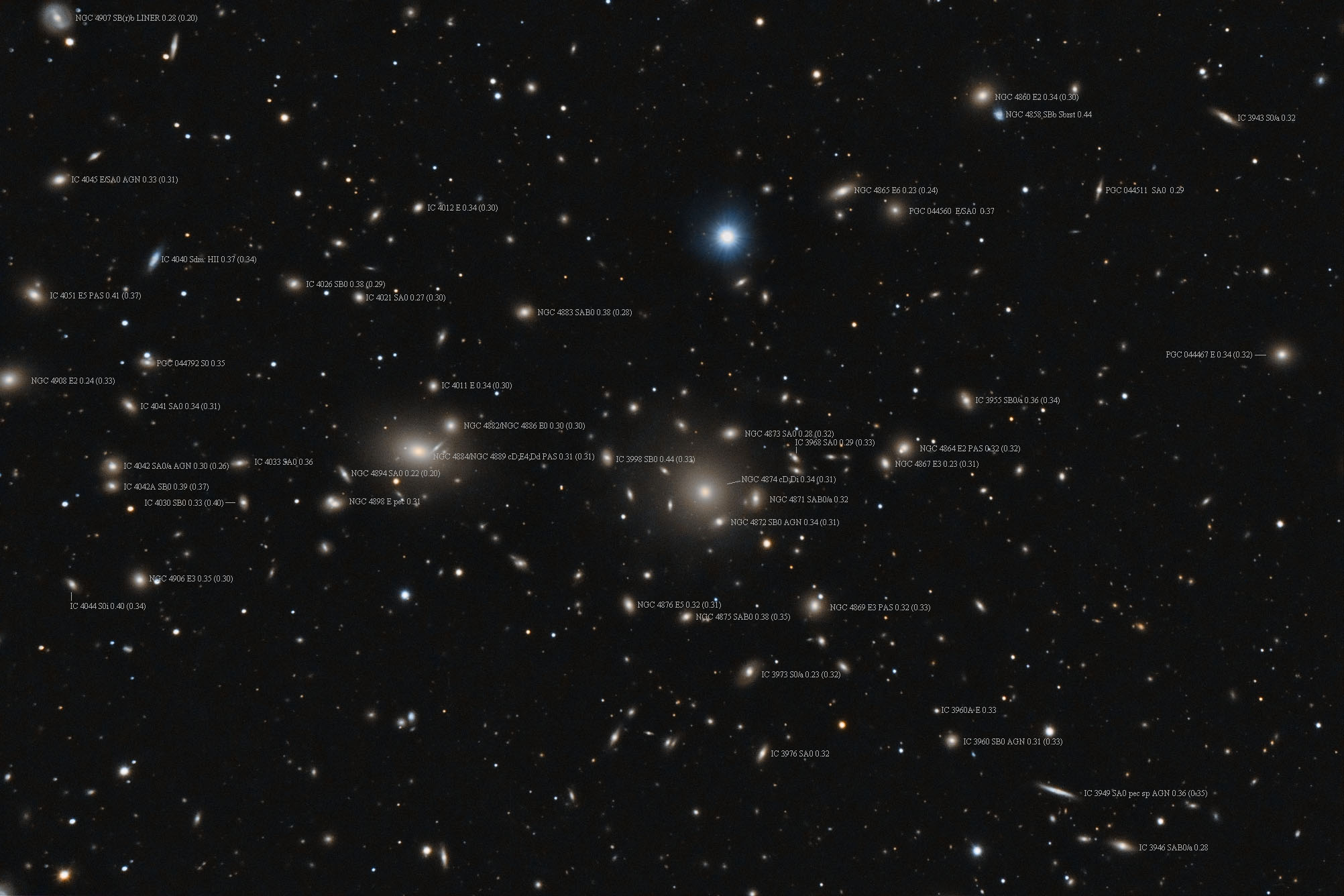
NGC4874L4X10RGB2X10ID.JPG
| ABELL 1758 is a rather large galaxy cluster in northwestern Canes Venatici that is about 3.2 billion light-years distant. It is listed at 22 minutes in diameter though it appears rather condensed into two parts a bit northwest of its center position. It is listed as richness class 3. Many think this dual nature is due to it being a near merger of two clusters
While the two parts mentioned above are each condensed around a bright large galaxy they are considered the northern part of the cluster. Below these, near the bottom of my image is the southern group though the biggest and brightest galaxy in this group is much closer and not a member of the group. Still, most simulations of the merger show the two northern parts rather than the southern one. Search the term " abell1758 galaxy cluster " for links to video and published articles on the merger.
This was a very early image when I was just testing out how faint my system could go. I never did take color data on it and processing was crude as my skills were very limited and my processing tools even more so. Not having easy access to the raw data which is on a hard drive under my stairs I made only minor improvements to the already badly processed TIFF image. For now, this will have to do.
14" LX200R @ f/10, L=4x10', STL-11000XM, Paramount ME | 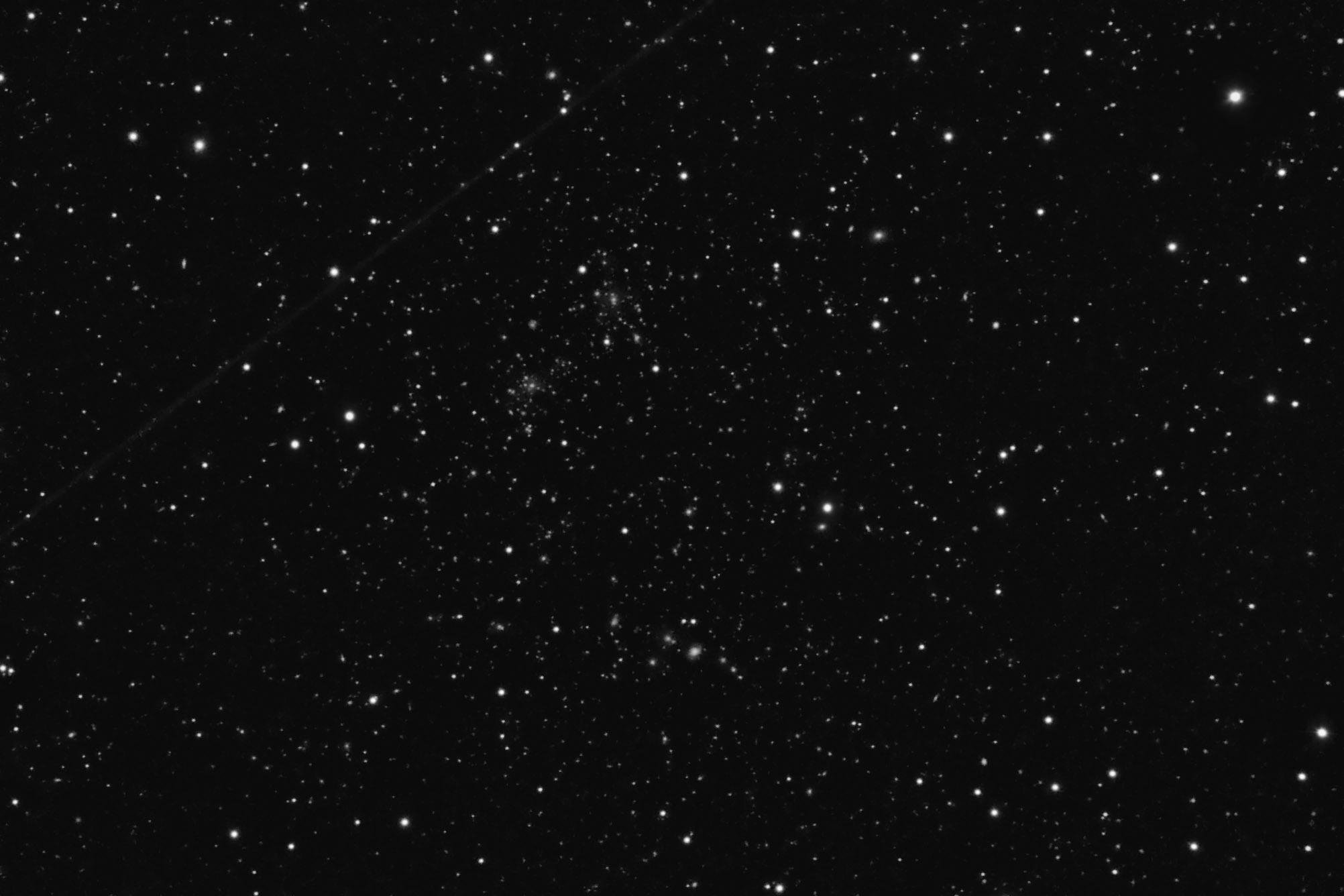
ABELL1758L4X10.JPG
| ABELL 2065 is also known as the Corona Borealis Galaxy Cluster. Along with ABELL 2061, 2067, 2079, 2089 and 2092, it is part of the Corona Borealis Supercluster, I've not imaged the others as yet. In fact, this one was an early attempt to check out the capabilities of my system to image distant galaxy clusters at a billion light-years. NED puts this one at .96 billion light-years. As it was just a test I never did collect color data for it. Something I should remedy all these years later. NED lists it as having a diameter of 44 minutes of arc, larger than my field but most of them are concentrated in a much smaller area. It has no galaxy that could be considered a core galaxy for the cluster. It is richness class 2 which indicates it has 50 to 79 galaxies that meet a specific brightness range which is the magnitude of the third brightest member to two magnitudes fainter so is not a real count of all the galaxies but reflects both number and how even they are in brightness.
14" LX200R @ f/10, L=6x10', STL-11000XM, Paramount ME Related Designations for ABELL2065ABELL 2065, CrB CLUSTER, ZwCl 1520.0+2748, SCL 158 NED03, RBS 1491, PLCKESZ G042.82+56.61, 1RXS J152225.9+274232, MAXI J1522+279, 1ES 1520+278, [HMS56] 1520+2754, ABELL2065, | 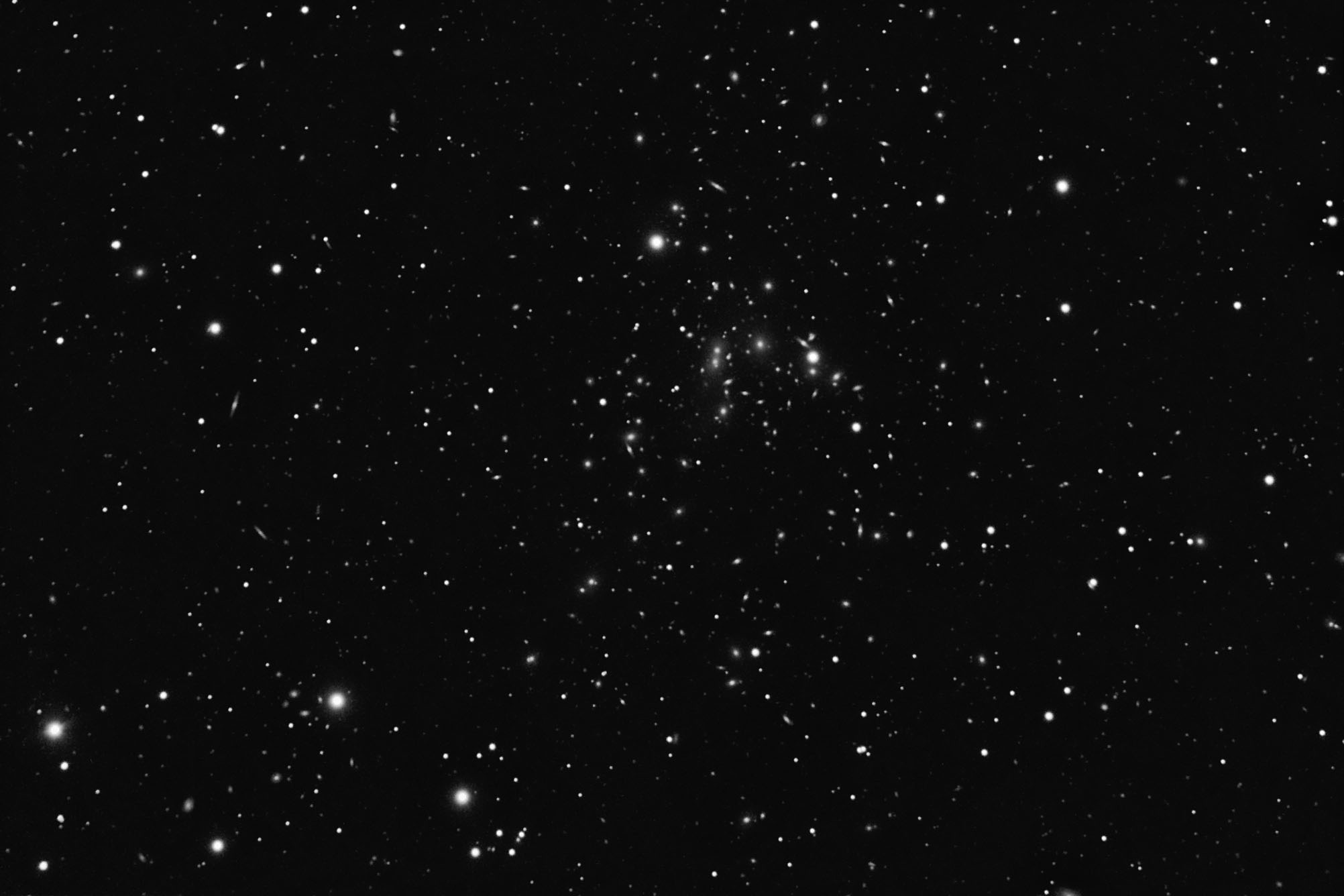
A2065_6X10r.jpg
| Abell 2197 is a moderately condensed galaxy cluster containing over 50 galaxies, most "big and bright" at least compared to most Abell clusters. It too is too large for my field but I was able to capture much of it. It is about 420 million light-years from our galaxy and located in Hercules, just not THE Hercules Galaxy cluster which is Abel 2151. The cluster is rather linear in nature with two widely spaced large elliptical cD galaxies, each the center of a portion of the cluster designated as Abell 2197E and 2197W.
NGC 6160 anchors the western half of the cluster. Interestingly the two rather bright galaxies nearest it belong to a group about 3 times further away so are not members of the cluster. NGC 6163 anchors the eastern half. Besides being a cD elliptical it houses an AGN. Likely its massive black hole is still feeding.
I've labeled all galaxies with redshift data that are likely cluster members. Since, as members of the cluster, they are all about the same distance -- a bit over 400 million light-years -- I've not noted distance as I usually do. Those listed only in catalogs that list them only in terms of sky coordinates (SDSS, 2MASS etc.) are simply noted as ACM for Abell Cluster Member. Otherwise, the labels would be difficult to fit on due to length. Galaxies and quasars (UvES objects are quasar candidates) are labeled by type (G for galaxy etc.) and distance in billions of light-years using NED's 5 year WMAP calculations for light travel distance. Labels are immediately right of the object unless a line connects the object and label.
There's a major problem with NGC 6174. Is it III Zw 082 or IV Zw 063? NED says the latter but notes Identification as NGC 6174 is very uncertain." But makes no remarks about III Zw 082 also being a candidate for that galaxy. The NGC project has extensive notes on it that are quite interesting. It prefers III Zw 082 as being NGC 6174. Their explanation is too long to include here. There's no direct link, unfortunately. Go to http://www.ngcicproject.org/dss/dss_n6100.asp and then scroll down to the button for NGC 6174 and click it (not the picture). Then scroll down to Historical Research Notes. This shows the problem with visual astronomy. Problems of this sort happened all too often with the NGC and other catalogs.
Between the two NGC 6174 candidates and down a bit is a cluster galaxy I labeled ACM Plume. It appears to be a dwarf member of the cluster with a huge plume. It is known only as SDSS J162937.03+405054.0. NED has nothing on it to help with the plume. It has obviously interacted with some other cluster galaxy. Was it the huge cD NGC 6173 or some other smaller galaxy?
NGC 6160 and NGC 6173 were discovered by William Herschel on March 18, 1878. NGC 6174, whichever one it is (I favor the westernmost galaxy of the three) was discovered by George Stoney on March 26, 1849.
14" LX200R @ f/10, L=8x10' RGB=2x10', STL-11000XM, Paramount ME Related Designations for ABELL2197ABELL 2197, CID 65, CAN 065, ZwCl 1625.5+4006 NED01, SCL 160 NED11, NGC 6160, UGC 10400, CGCG 224-032, CGCG 1626.0+4102, MCG +07-34-042, GIN 563, WISE J162741.13+405537.1, 2MASX J16274107+4055368, 2MASXi J1627410+405536, 2MASS J16274111+4055370, SDSS J162741.11+405537.0, SDSS J162741.12+405537.0, SDSS J162741.12+405537.1, SDSS J162741.13+405537.0, SDSS J162741.13+405537.2, CAN 065 NED02, USGC U766 NED32, ASK 164944.0, NSA 029530, PGC 058191, PGC 058199, UZC J162741.1+405537, FIRST J162741.1+405537, 18W 005, RX J1627.6+4055, RX J1627.7+4055, 1RXS J162741.8+405536, 2XMM J162741.1+405537, 2XMMp J162741.1+405537, ABELL 2197:[DGP89] 0016/7JTR , ABELL 2197:[CBW93] B, ABELL 2197:[PL95] G2, ABELL 2197:[BTM97] 2, RX J1627.6+4055:[BEV98] 003, RX J1627.6+4055:[ZEH2003] 03 , [BFW2006] J246.92138+40.92696 , Mr18:[BFW2006] 04792 NED97, Mr19:[BFW2006] 09501 NED68, Mr20:[BFW2006] 16089 NED23, [GMM2009] 0701900, [HIV2012] 1051, [HIV2012] 5353, ABELL 2199:[HIV2012] 0197, B2 1621+38:[HIV2012] 0085, [TTL2012] 402759, [DZ2015] 769-01, [LHL2015] 0344, NGC 6173, UGC 10421, CGCG 224-049, CGCG 1628.1+4055, MCG +07-34-083, GIN 562, WISE J162944.90+404841.8, 2MASX J16294485+4048421, 2MASS J16294489+4048419, SDSS J162944.87+404841.9, SDSS J162944.88+404841.9, SDSS J162944.99+404841.7, WBL 618-001, LDCE 1190 NED020, HDCE 0952 NED001, CAN 065 NED01, USGC U766 NED11, ASK 165389.0, HOLM 753A, NSA 029682, PGC 058348, UZC J162944.9+404842, FIRST J162944.8+404841, NVSS J162944+404842, 18W 008, RX J1629.7+4048, 1RXS J162944.5+404843, CALIFA 840, 2XMM J162944.8+404842, 2XMMp J162944.8+404841, ABELL 2197:[DGP89] 1753/7JBL , ABELL 2197:[CBW93] A, ABELL 2197:[PL95] BCG, ABELL 2197:[BTM97] 1, [M98j] 252 NED02, [MO2001] J162944.9+404840.6, [BKH2005] 0816-184, [BFW2006] J247.43699+40.81165 , Mr18:[BFW2006] 04792 NED237, Mr19:[BFW2006] 09501 NED145, Mr20:[BFW2006] 16089 NED65, [GMM2009] 0395749, [HIV2012] 1280, [HIV2012] 5423, ABELL 2199:[HIV2012] 0426, B2 1621+38:[HIV2012] 0155, [TTL2012] 404956, SDSS J162944.91+404841.7, [DZ2015] 772-01, [LHL2015] 0207, NGC 6174, NGC 6174 NED02, IV Zw 063, CGPG 1628.1+4059, ABELL2197, NGC6160, NGC6173, NGC6174, | 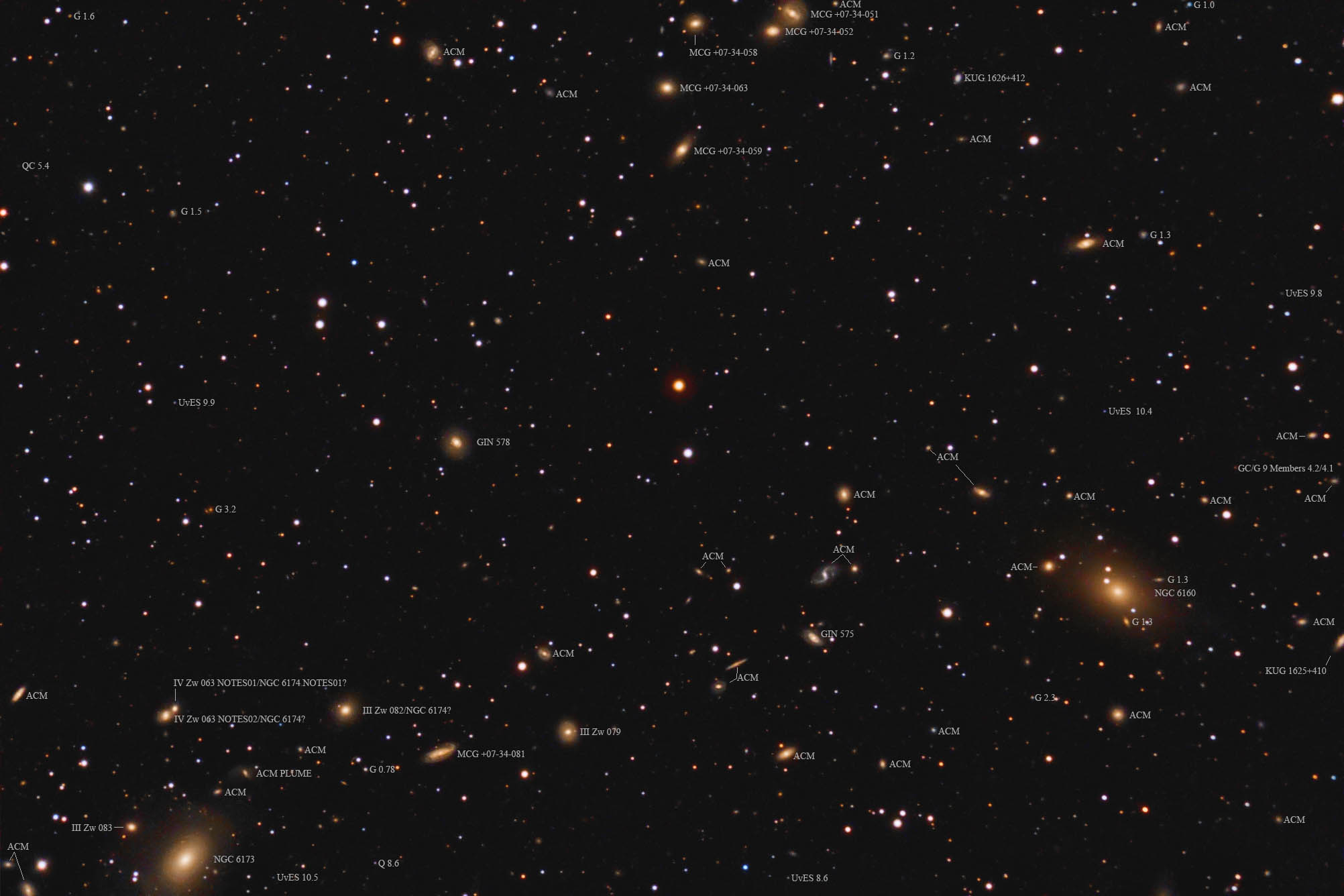
ABELL2197L8X10RGB2X10-ID.JPG
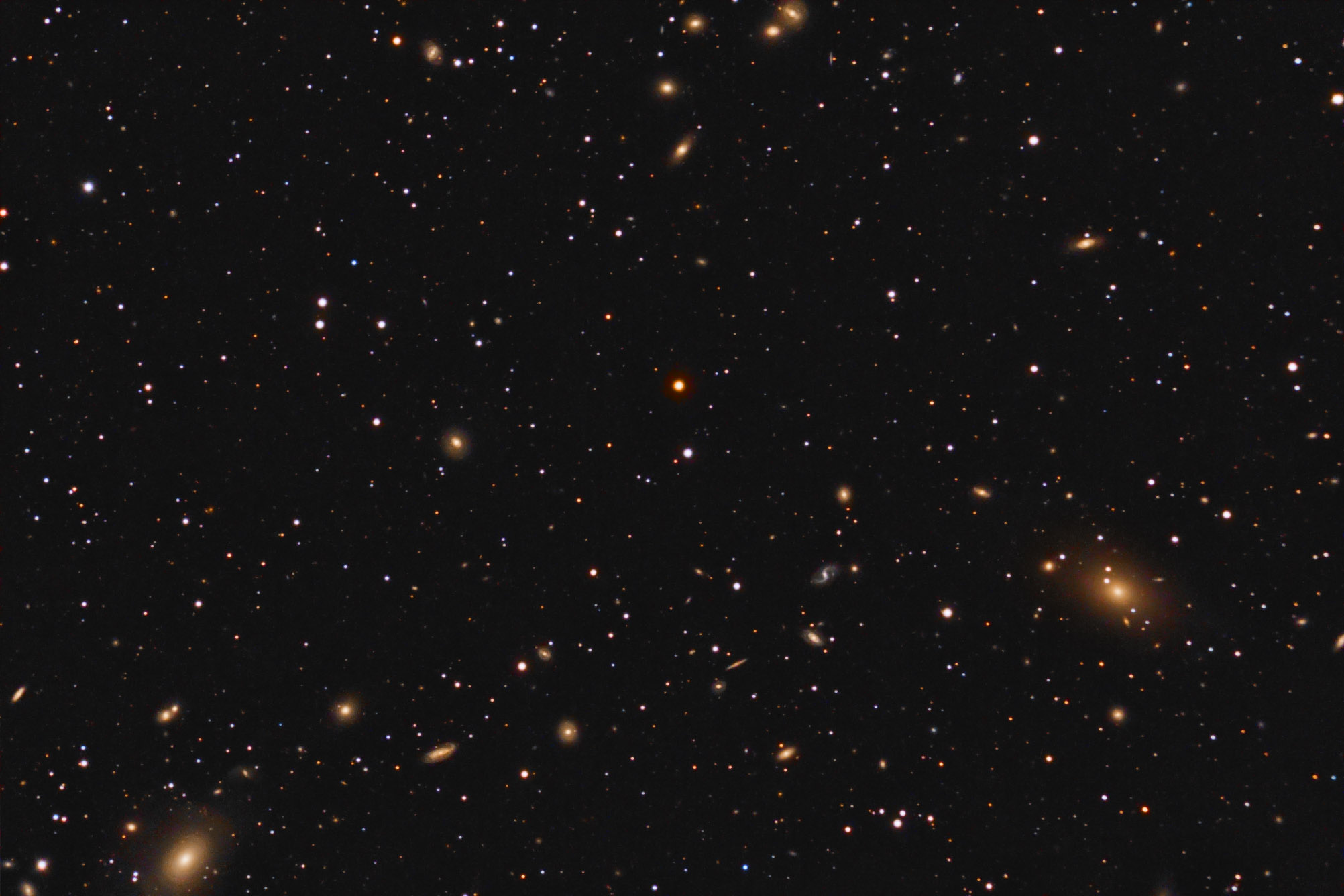
ABELL2197L8X10RGB2X10.JPG
| ABELL 2218 is a galaxy cluster in Draco over 2 billion light-years distant. The reason I took it is that it has some rather "bright" gravitational arcs of far more distant galaxies behind the cluster that I thought were within reach. To the northeast of the cluster is an interesting Sa spiral galaxy PGC 058586 at only 328 million light-years. It has an orange companion to the south end and a plume stretching from that companion to the east. I thought these an interacting pair but NED puts the "companion" at the same distance as the cluster making it a cluster member some 7 times further away. The source of the plume remains a mystery it seems.
The first image of the cluster is at my usual image scale of 1" per pixel. I did this one back in 2008 when I wasn't taking satellites out of my image as I do now. Two are visible in the image. At this scale, the arcs are difficult to see. The second image is at the image scale of 0.5" per pixel. Now you can start to see the arcs I picked up. The third image is annotated and enlarged to 0.25" per pixel. Beyond my system's resolution but does make pointing out the arcs easier. I've also included the HST image at the same scale for comparison.
Arc A, galaxy 362 and galaxy 468 are all the SAME galaxy. It is located some 10.7 BILLION light years from us and 8.7 billion light years beyond the lensing cluster Abell 2218. Arc A has a magnitude of 22.35. Arc 362 is listed by NED as magnitude 24.52 while 468 is magnitude 23.74 Image 468 is virtually undistorted but even Hubble can't see much detail in it. Arc A, once deconvolved shows more detail. This is a very interesting galaxy. You can read more about it at:
http://arxiv.org/PS_cache/astro-ph/pdf/9802/9802230v1.pdf
This is a PDF file you need a PDF reader to view it.
The idea I could see things this faint is far beyond my expectations when I designed the observatory. Note the article says the true magnitude of the galaxy is 14.5 times fainter than this. So I'm only seeing it thanks to one of the universe's largest telescopes, one that is millions of light years across but with a rather imperfect lens.
Arc H is rather bright in Hubble's image but my CCD is rather insensitive to its red color making it harder for me to pick up. It is listed as being 6.1 billion light years from us, 4 beyond the imaging cluster and is listed at magnitude 24.4 which seems low to me.
Arc 323 is listed at 22.2 magnitude and is only 4.1 million light years away so it is about from the lensing cluster as we are from the cluster. It may be the brightest arc but it is rather lost in the galaxy making it hard to see in my image.
Arc L is interesting in that it is two arcs if you look closely at the Hubble image. A blue arc and a rather small red blob near one end. It all merges together in my "low resolution" image. Anyway, the blue arc is a quasar that was located in just the right spot to be highly distorted into a blue arc by the lens yet the galaxy around it is nearly undistorted. Redshift data shows both to be at the same distance of 7.6 billion light years and the combination shines at magnitude 23.4.
The remaining object is galaxy 308. It too seems rather undistorted. It is magnitude 23.39 and is 5.6 billion light-years away. If you compare two images other lensed galaxies can be seen as well but I was unable to get much info on them so I'll stop here.
The Abell cluster is listed as being BM type II meaning its galaxies group around two major galaxies. The northwestern one seems to have a large halo about it from all the members it has devoured in the past. It is LEDA 140648 at about magnitude 17. Redshift puts it at 2.14 billion light-years which we can assume is a good estimate for the cluster's distance. NED shows a diameter of 20 arc minutes which seems about twice as large as it appears in my image though some of the faint fuzzies beyond its obvious edges may be members. There were too many for me to try and look up. The cluster is listed at richness class 4 which means that starting at the magnitude of the 3rd brightest member and going 2 magnitudes fainter there are 200 to 299 galaxies. It makes no attempt to count the galaxies fainter than this of which there are many. Clusters with more than 299 in this range are the highest class -- 5. This puts ABELL 2218 among one of the richest ABELL clusters. To go this faint I used 2 hours of luminance data rather than the 40 minutes used for most of my images.
14" LX200R @ f/10, L=6x20' RGB=2x20', STL-11000XM, Paramount ME Related Designations for ABELL2218ABELL 2218, NSC J163553+661240, ZwCl 1635.4+6618, MCXC J1635.8+6612, RBS 1596, PLCKESZ G097.73+38.11, 1RXS J163553.7+661243, RXC J1635.8+6612, 1WGA J1635.9+6635, EXSS 1635.7+6618, 1ES 1635+663, ABELL2218, PSZ1 G097.72+38.13, | 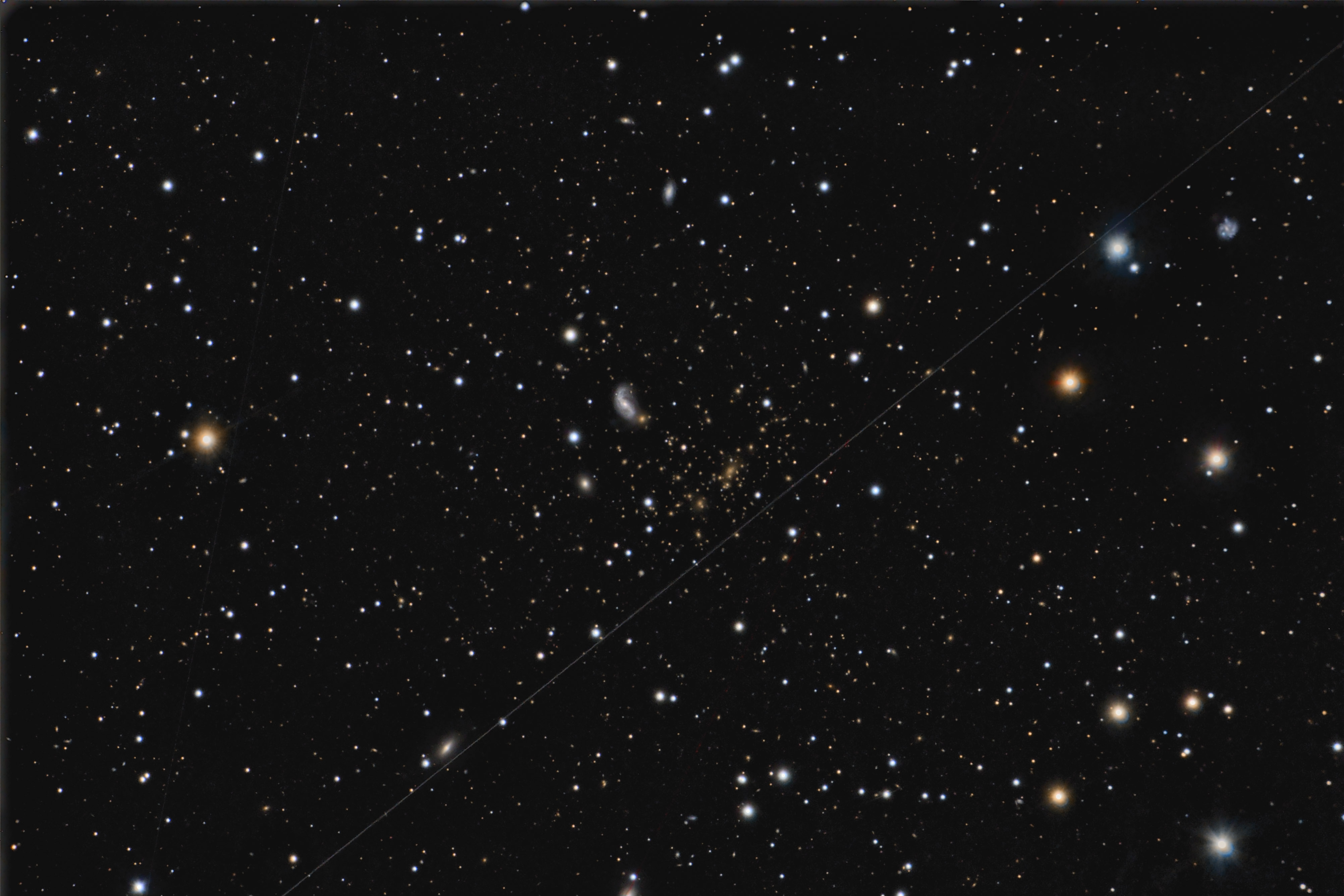
LUM6X20X1RGB2X20X2R.JPG
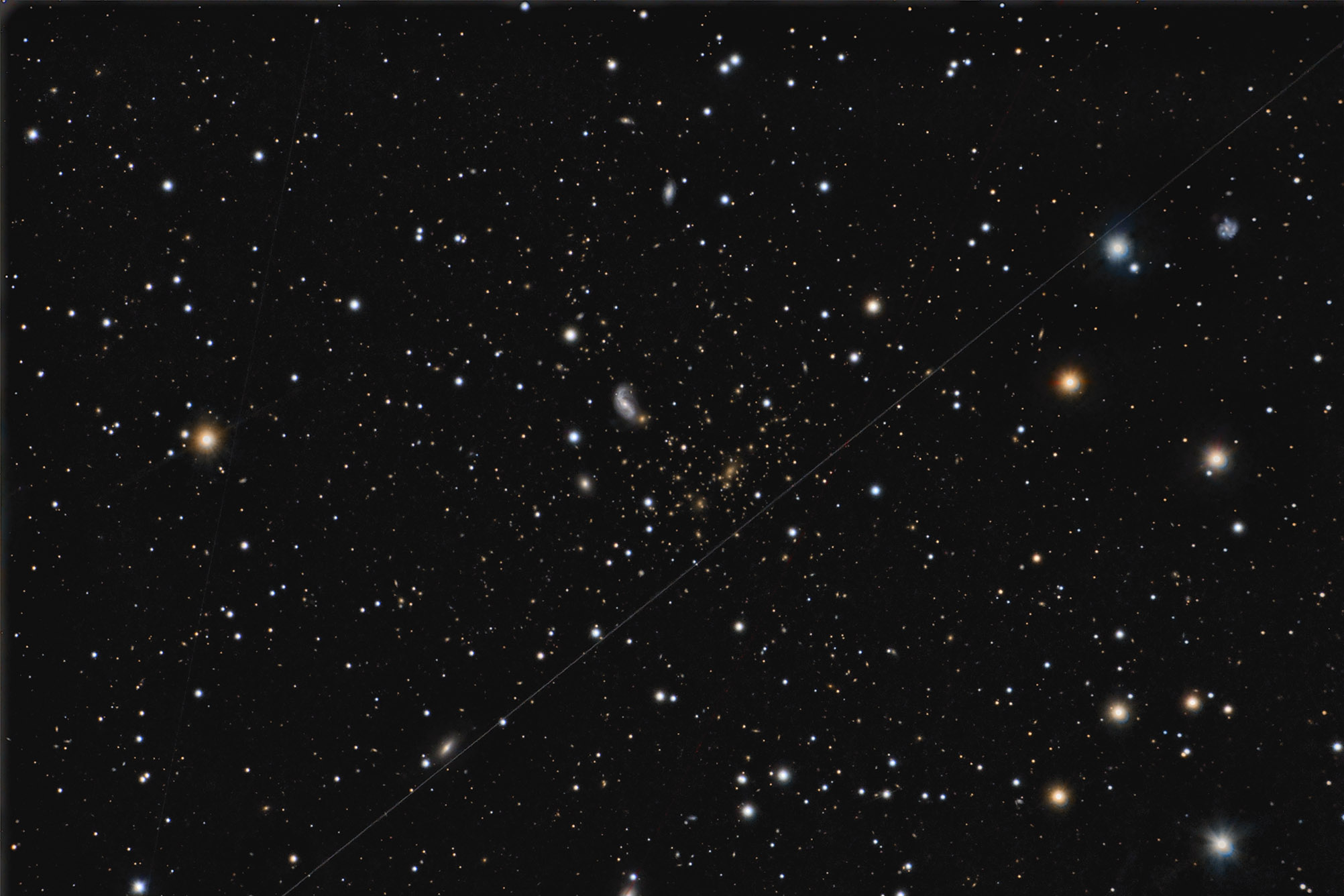
LUM6X20X1RGB2X20X2R50.JPG
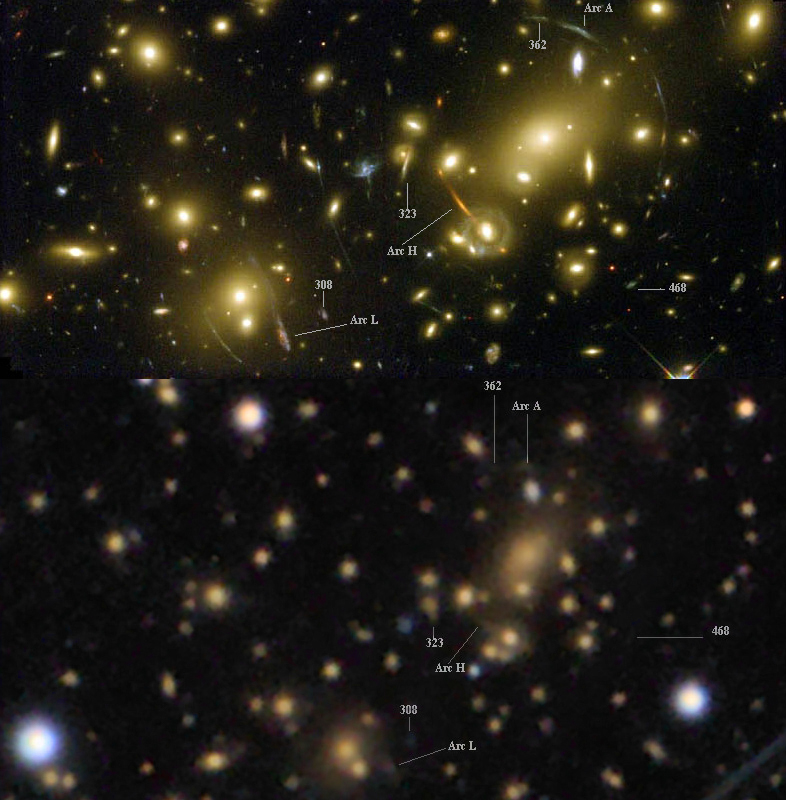
LUM6X20X1RGB2X20X2R_crop8compare.JPG
| The Abell Galaxy cluster #2256 is the Abell cluster closest to the celestial pole at a declination of 78 degrees 43 minutes. I expect that is what drew it to my attention, that and it is a rather rich cluster. It is located east of the bowl of the Little Dipper, Ursa Minor. NED lists its redshift distant as about 770 million light-years and gives it a diameter of 140 minutes, far larger than my field of view which is centered on the core region. The cluster is listed as having 86 members and being class II-III using the BM classification system. Class BM II means it has several bright galaxies that are between cD and gE classification and BM III has no dominant galaxy. In this case it has many scattered galaxies meeting the BM II classification but they don't really define a core region.
NED lists over 200 galaxies with a redshift that makes them likely candidates for the cluster. Too many for me to annotate without so filling the image with text that would be very difficult to decipher. Instead I've only annotated those obviously too distant to be members. That's not very many. So nearly all the bright galaxies in the image are likely members of the cluster.
I've also labeled the few galaxies with common catalog designations from the NGC, UGC, CGCG etc. NGC 6331 is listed by NED as being the southernmost of three galaxies in a common halo. Seligman says it is the one above and to the right. Other sources list the bottom two and sometimes all three as NGC 6331. The three are also CGCG 355-024. That catalog lists it as a triple. So you are free to see this one as you wish; one, two or three galaxies. Whichever it is, I vote for at least the lower two, it was discovered by William Herschel on December 20, 1797.
Note that many of the ellipticals in this area share their halos with other members of the cluster indicating lots of interaction is going on in this group. I pushed the low levels hard to bring out these faint halos with my short exposure time. I hope I didn't create serious artifacts by doing so. Makes me wonder if, given enough time, this region will become one mega elliptical galaxy.
In the upper left corner is a red K2 star (seems too red for that spectral class), in its glow to the northwest is a possible galaxy. Interestingly it doesn't show in the POSS II plates nor in the Sloan Survey images being lost in the glare of the star. Yet it is quite obvious in my image. There's a hint of it in the POSS 1 blue plate as an out of round lump in the correct position. NED lists nothing at that position. I think it is real, just that all surveys to date aren't seeing it for the glare of the 8.5 magnitude K2 star, SAO 8727.
14" LX200R @ f/10, L=4x10' RGB=2x10', STL-11000XM, Paramount ME Related Designations for ABELL2256ABELL 2256, UGCl 411, ZwCl 1653.9+7856, SCL 168 NED02, PLCKESZ G110.98+31.73, MAXI J1703+785, 2PBC J1704.0+7836, XSS J17050+7838, ABELL 2256:[RBP2007] M, NGC 6331, CGCG 355-024 NED02, CGCG 1706.3+7842 NED02, MCG +13-12-015 NED02, 2MASX J17033591+7837435, 2MASS J17033580+7837438, WBL 632-001, WINGS J170335.96+783744.3, WINGS J170335.97+783744.4, NSA 167203, LEDA 084830, UZC J170335.0+783747, ABELL 2256:[D76] 323, ABELL 2256:[FD77] A, ABELL 2256:[D80] 046, ABELL 2256:[FKK89] 083, ABELL 2256:[BS90] 48-2, ABELL 2256:[CAE99] a, ABELL 2256:[BLC2002] 0428, UGC 10726, CGCG 355-027, CGCG 1707.2+7843, MCG +13-12-018, 2MASX J17042724+7838260, 2MASS J17042716+7838257, GALEX J170427.0+783826, GALEXASC J170427.02+783826.1 , WBL 632-003, WINGS J170427.22+783825.4, WINGS J170427.23+783825.4, NFP J170427.2+783825, NPM1G +78.0097, UZC J170427.2+783825, 2XMM J170426.2+783827, ABELL 2256:[D76] 259, ABELL 2256:[FD77] D, ABELL 2256:[D80] 039, ABELL 2256:[FKK89] 095, ABELL 2256:[BS90] 01, ABELL 2256:[SDG94] B, ABELL 2256:[LO95] C21, ABELL 2256:[CAE99] d, ABELL 2256:[BLC2002] 0581, [PMP2006] J170427.3+783825.1 , ABELL 2256:[AAV2011] BCG, ABELL 2256:[ZAC2011] BCG, ABELL2256, NGC6331, UGC10726, SDSS J170427.18+783824.6, PSZ1 G110.99+31.74 BCG, | 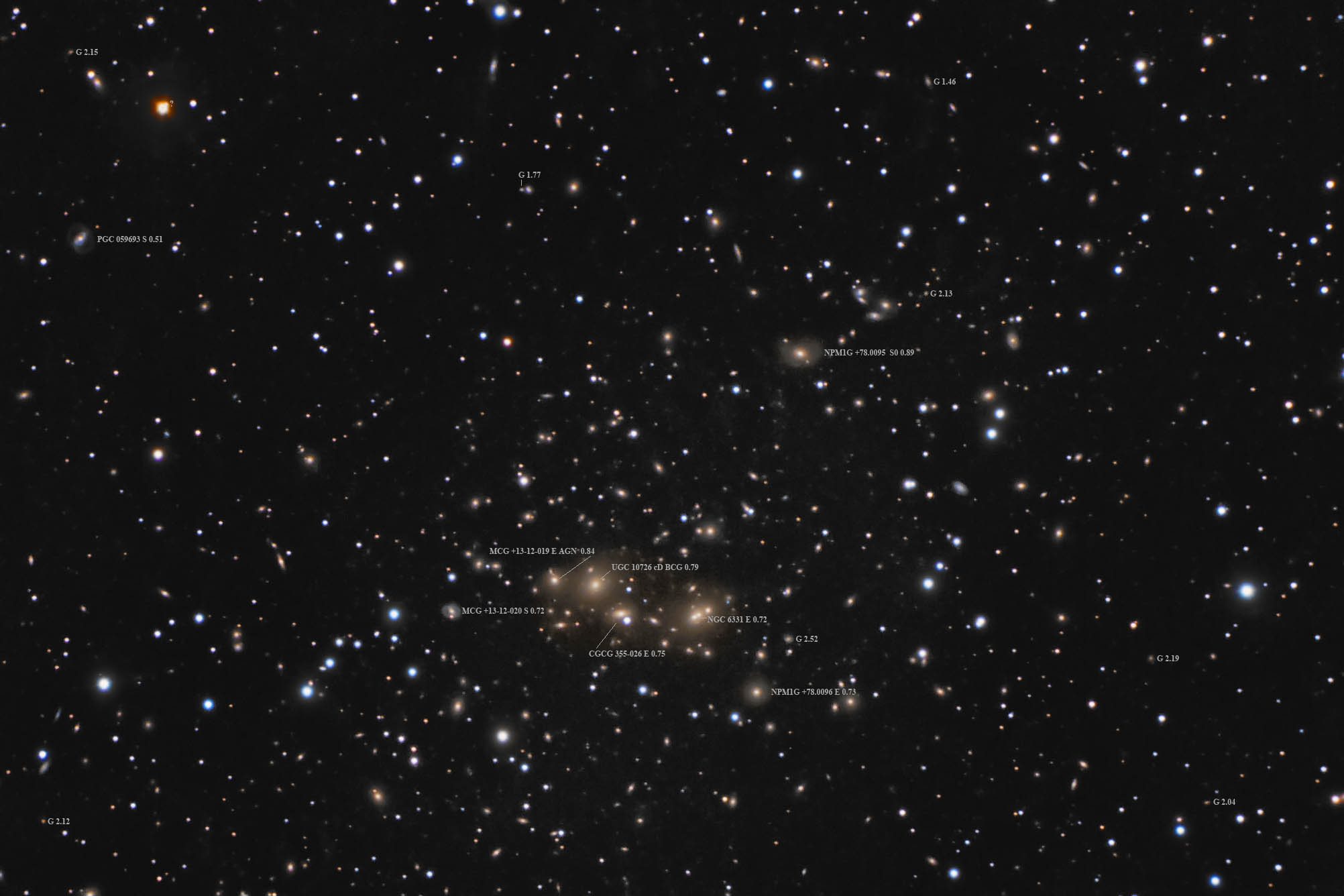
ABELL2256L4X10RGB2X10R-ID.JPG
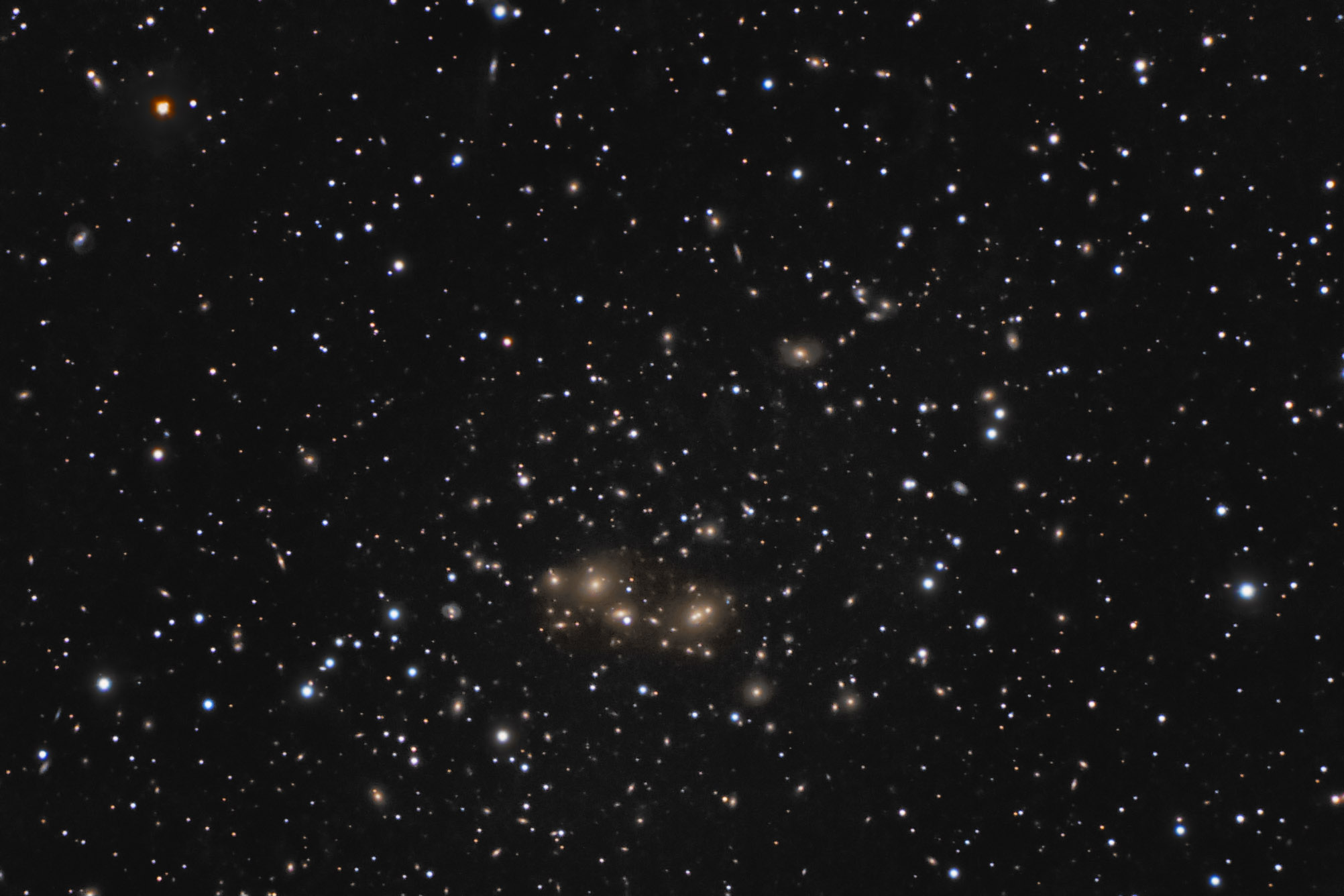
ABELL2256L4X10RGB2X10R.JPG
| Alberio is a famous double star for amateur astronomers at the head of Cygnus the Swan. Great for beginners and always a crowd pleaser for public groups. The reason is the two stars that our eye sees as one are easily split by even the much maligned "dime store telescope". They are quite different in temperature and thus spectroscopic type. One is an orange K3 giant star and thus orange-yellow while the other a main sequence B8e star. These are very hot stars shining more in ultraviolet light we can't see than in visible light. This results in a rather blue star. Even the "dime store telescope" shows this color difference very vividly.
We now know the K3 star itself is a double star of about 0.4" separation. It takes a large amateur scope in very good skies to see the companion which has made about 25% of its orbit since discovery so there's still some uncertainty about the orbit. The companion is a B9 dwarf star so much fainter. While Alberio's two main stars are about the same distance away from us, 380 light-years +/- 30, it is uncertain if the two are actually a true double and thus orbiting a common center of gravity or just share a common proper motion across the sky. If they are orbiting the period would have to be very long, 75,000 would be a minimum estimate. Estimates go well over 100,000 years.
The golden star has a temperature of about 4400K compared to our sun's 5000K temperature and is about 50 times larger in diameter (125,000 times by volume). It is about 5 times as massive as our sun with means most of its size is a pretty good vacuum! But being a giant gives off about 950 times the light of our sun. The blue star is a B8e main sequence star of about 12,100K, 190 times brighter than our sun with 3.3 times the mass. It is rotating at 250 km per second. Astronauts orbit the earth at a bit less than 8 km per second. The e means the star is an emission star so losing mass, mostly hydrogen its UV light causes to glow creating an emission line where most stars have an absorption line. The mass loss is likely related to hits high spin rate.
Note a similar gold/blue pair in the lower right of my image.
14" L200R @ f/10, RGB=5x1', STL-11000XM, Paramount ME Related Designations for ALBERIOALBERIO, | 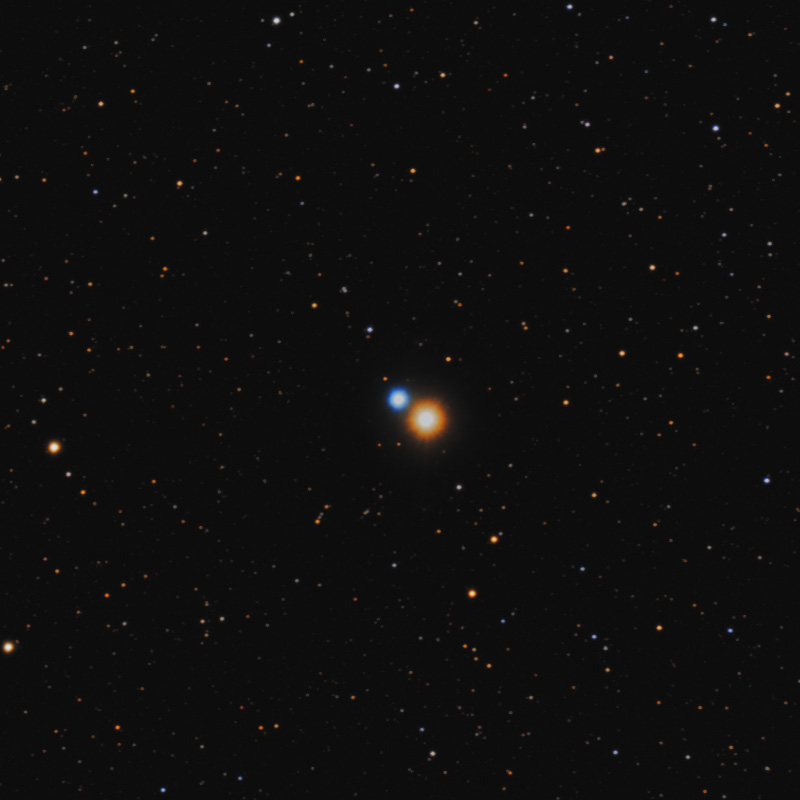
ALBERIO-RGB5X1-CROP.JPG
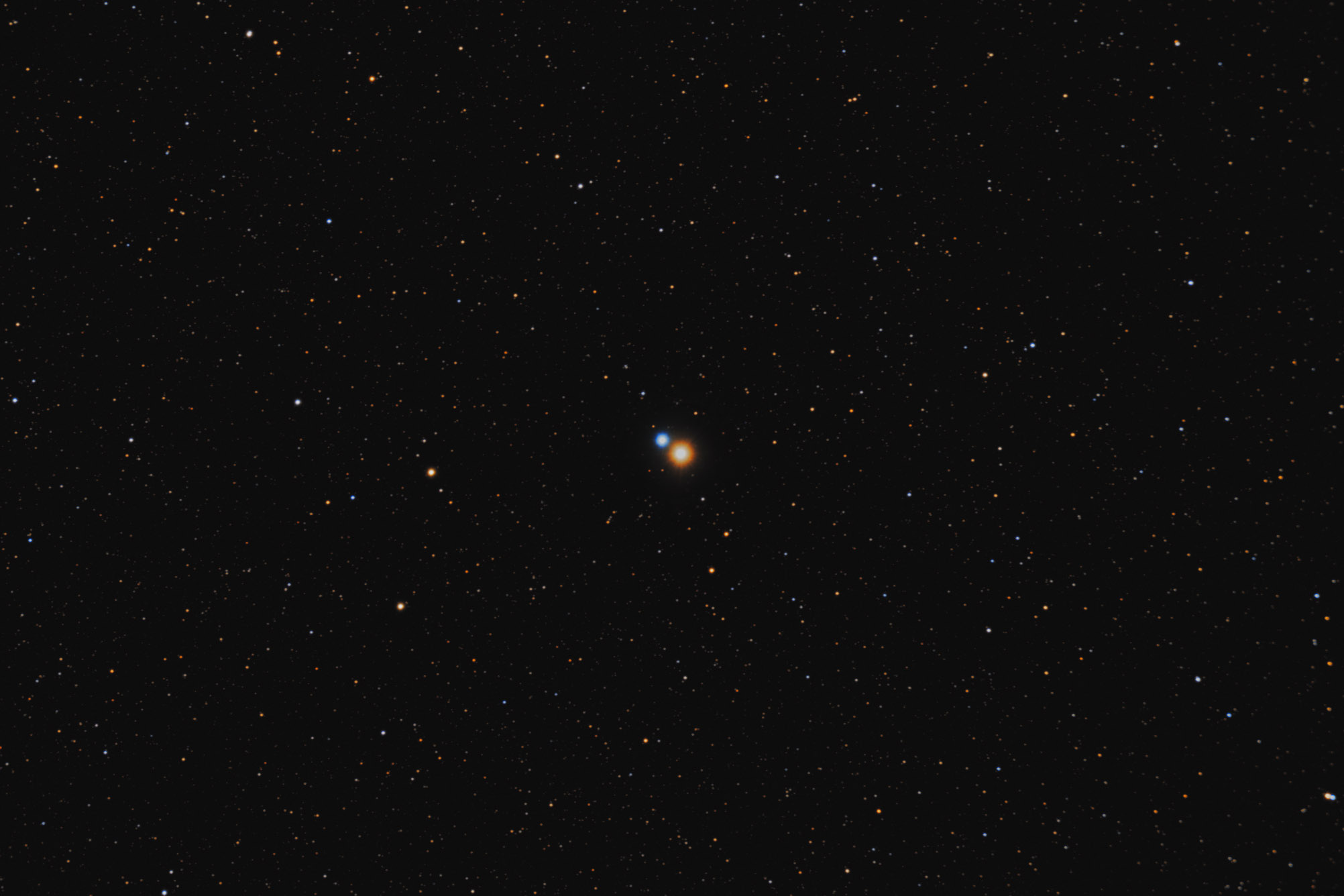
ALBERIO-RGB5X1.JPG
| My target was And IV so I'll start there then go to what else I picked up unknowingly until I researched the image. And IV is a very interesting and difficult target by itself.
Andromeda IV is a something seen in the outskirts of M31. What that something is is still being debated. Originally it was thought to be a satellite of M31. If it is close to M31 and thus about 2.5 million light-years distant it is only about 1,000 light-years across its major axis. Darned small for even a dwarf galaxy. Since it is seen through the faint outer halo of M31 some said it was a star cloud in the galaxy. That at least would fit its small size as the NGC 206 star cloud is much larger than this object though all stars are too dim for me to see. This means it is a very old cloud without the massive blue stars of NGC 206. Yet its color is very blue. It's redshift while positive is very small, essentially worthless for determining its distance. Though if it was in M31 I'd expect its redshift to be negative since the galaxy is heading for us or us to it or both. Many predict a collision in a few billion years. A single tip of the red branch measurement at NED puts it some 6.3 mega parsecs distant (20.5 million light-years). That would make it some 8,000 light-years across which is reasonable for a dwarf galaxy and would explain why I see no individual stars in a galaxy that is very blue indicating it has massive, bright stars. A note at NED also agrees saying it is likely 5 to 8 mega parsecs distant. That note indicates it along with three other galaxies form a filament of low-mass galaxies. http://www.aanda.org/articles/aa/pdf/2003/30/aa3819.pdf See page 828 near bottom of left column.
Since the above paper is the latest I find on this object and it fits what I see better than the other papers I'll go with it for now and move on to the "impossible" objects I picked up.
I prepared an annotated image. One thing I didn't expect was that I managed to image what are labeled at NED as planetary nebulae in M31! If correct that is not something I ever expected to be able to image. They are marked with PN followed by their designation in the annotated image. Some are so faint they may not have survived the JPG losses of the annotated image though can be seen in the lower compressed full image once you know where to look. Unfortunately, I found so many obvious errors involving other objects in the image I'm not all that confident they really are planetary nebulae. These errors involve objects NED labels as *Cl which stands for star cluster, both globular and open use this label. While some of the blue ones seen in the edge of the brighter edge of M31 are likely open clusters many of the others are obviously distant background galaxies rather than globular clusters. When it is quite obvious the *Cl label is wrong I put what I feel is correct, usually G for galaxy in parentheses. Globulars that are likely correctly labeled all come from the Bol catalog of globular clusters in M31. Rather than using *Cl, which I reserved for apparent open clusters, I just used the Bol number. Some Bol entries were actually labeled as galaxies and will carry the G label without parentheses. Others have no red shift but look to me to be galaxies. Those are labeled *Cl? without the (G). A couple of the brighter galaxies without redshift data are labeled with their catalog name.
This brings me to the last object. It is near the eastern (left) edge of the image and is marked with ???. It's not in NED at all and is the color of an object shining with some H alpha emission, that is pink in color. Some planetaries are this color but it is several seconds of arc across making it too big for a planetary in M31 (considering its brightness). It might be a planetary in our galaxy or it might be an emission nebula in M31 that just happens to be round or it is something else. For now. I have no idea what it is. I did try imaging it through my H alpha filter. It didn't enhance much but didn't dim it much either. Thus my guess, for now, is it is a distant galaxy reddened by dust and by a rather higher H alpha emission than is typical for such galaxies. I don't have an OIII filter which, if it is there would indicate a possible planetary nebula. I consider that unlikely, however.
HST image of And IV: http://upload.wikimedia.org/wikipedia/commons/0/0b/Andromeda_IV_Hubble_WikiSky.jpg
14" LX200R @ f/10, L=4x10' RGB=2x10', STL-11000XM, Paramount ME | 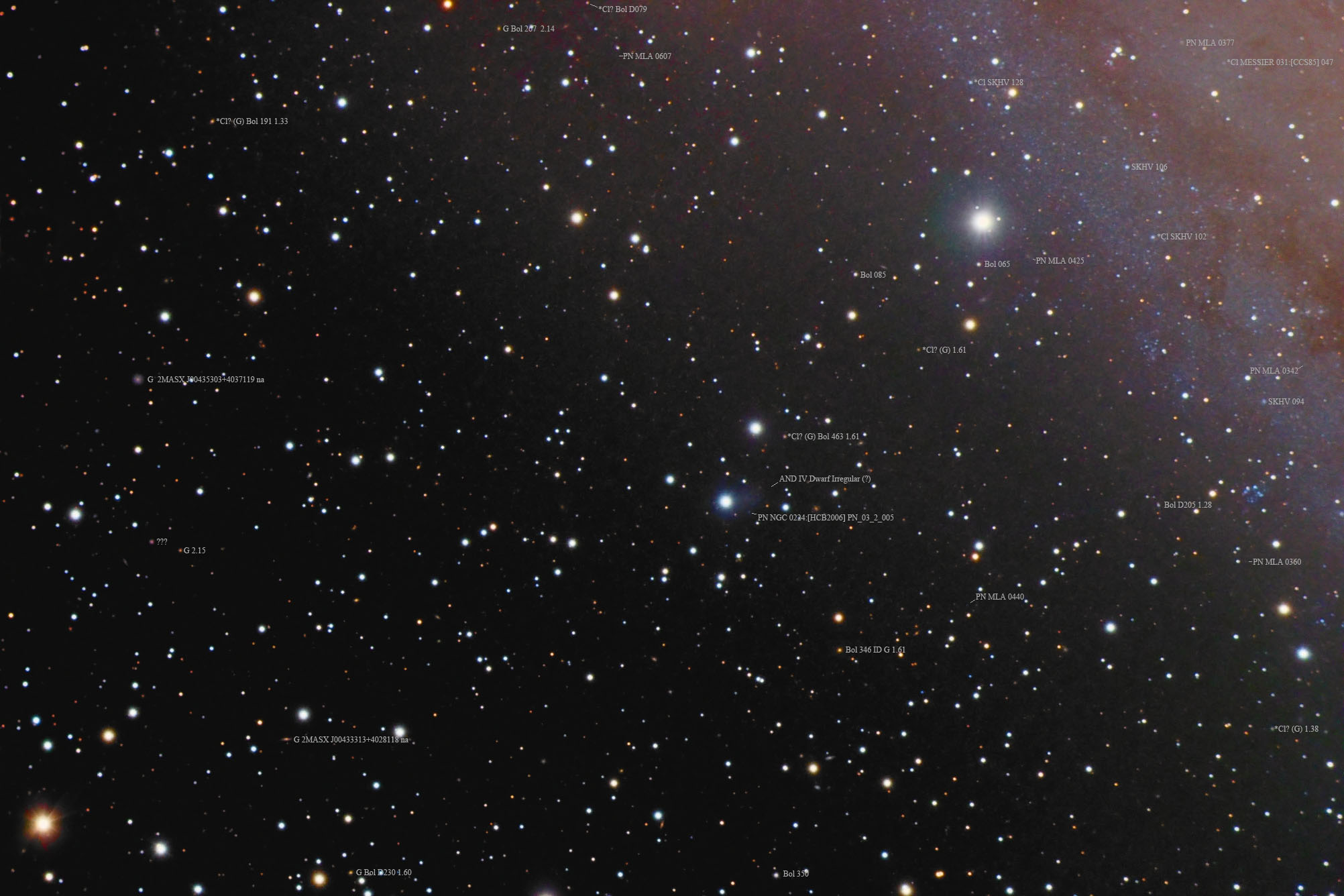
AND_IV_L4X10RGB2X10ID.JPG
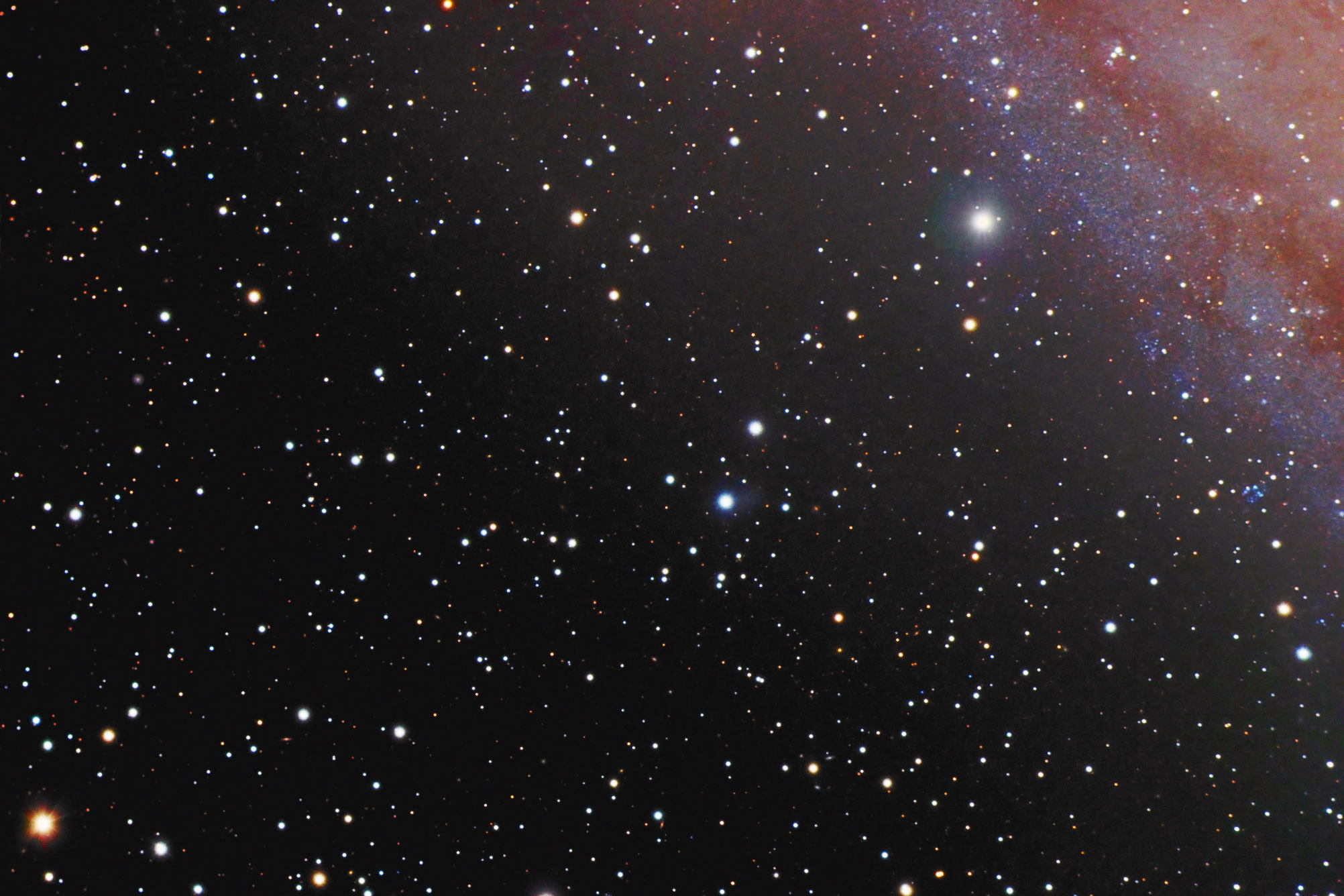
AND_IV_L4X10RGB2X10R.JPG
| 



















